Living and working on the AVA’s Kitoko Vineyard, Langner owns the brand Hesperian Wines and has been rebuilding his property since 2017.
2019 Review
February 16th, 2023
Winemaker / farmer / vintner Philippe Langner reviews what went into making his 2019 Hesperian Wines. He then tastes and evaluates each; Pawa, Witha & Kitoko Cabernet Sauvignons, providing insight into how they will evolve over time.
Blending The 2021 Vintage
April 7th, 2022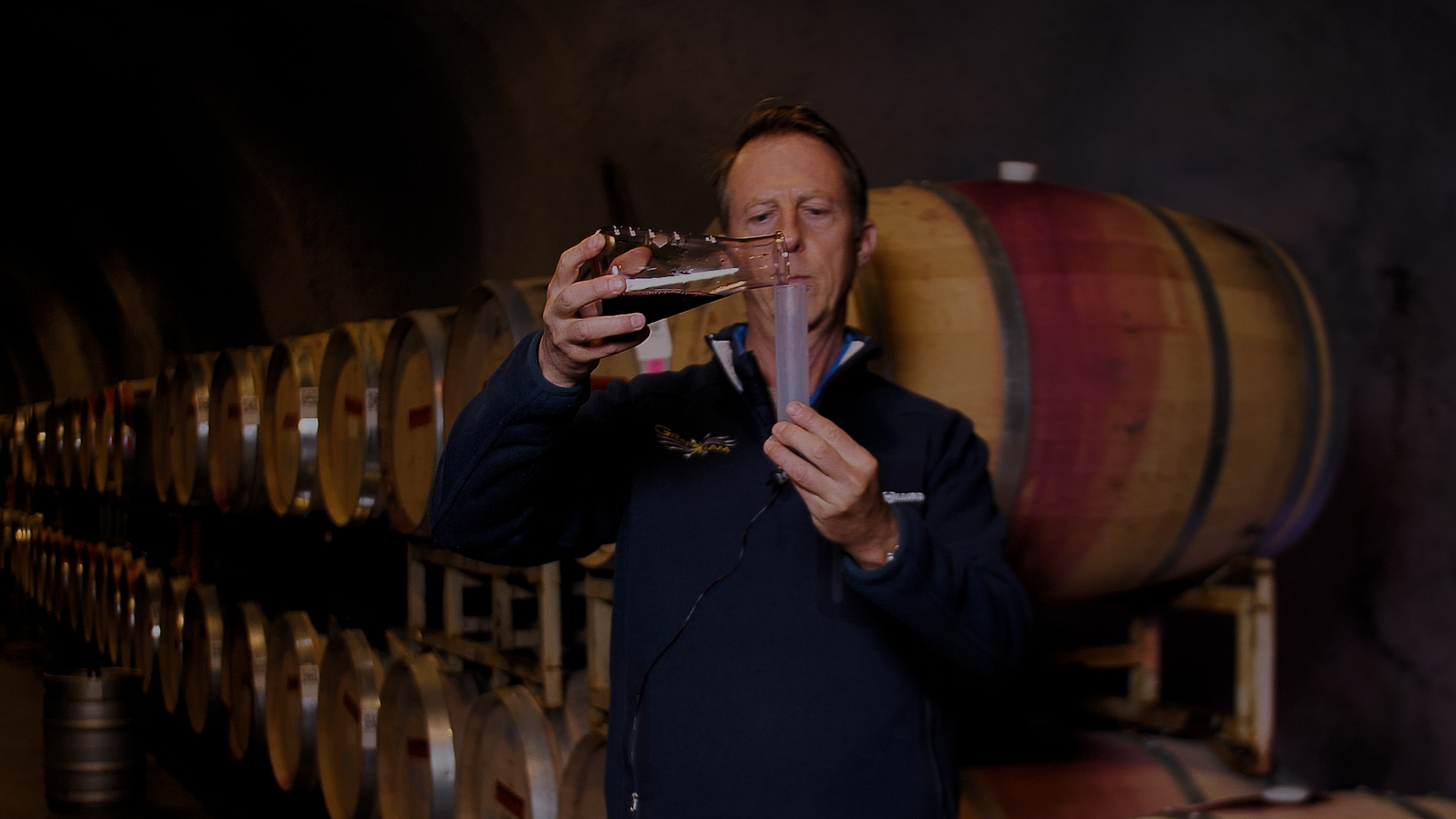
I am excited to share the most recent blending of the 2021 Hesperian Wines.
Since acquiring Kitoko Vineyard in 2010, I have worked hard to improve the vineyard. I started by re-training the vines from a quadrilateral to a cordon system which is more appropriate to the growing conditions of Atlas Peak’s rocky soils . Watering also changed a lot through the years as I noticed the vines needed more water to develop more harmonious tannins. I also started fertilizing a bit more (but still very small amounts) to compensate for the poor soils. All this resulted in happier vines, more in balance with their environment and thus producing more balanced wines. The higher watering created slightly bigger berries that made for juicer wines as the overload of tannins that tend to come with my growing conditions was kept more in balance. The vines are also 10 years older then when I started; they are now 22 years old which means they are mature and have larger roots systems that reflect the terroir better. The fruit to canopy ratio is more in balance too. I also sell less fruit now which allows me to harvest larger quantities of fruit. I harvest small lots, from 2 to 5 tons, at various levels of ripeness from my various blocks that have different slopes, sun exposure and wind pressure. Each vineyard lot is fermented separately and then aged separately in barrel. I also use three fermentation techniques now: pump-overs, punch downs and barrel fermentations. I have many small lots with different textures and aromas which allows me to craft more nuanced, complete, complex and layered wines
I used to blend 6 months before bottling and typically the wines were made up of two or three lots. For the 2021 vintage I blended 5 months after harvest or 15 months before bottling. It was a much more difficult proposition because I have to anticipate much further in time how tannins will evolve but also because of the many small lots I now have. The creative experience is stressful for me, I carry it with me throughout the day and everyday until I get it right and I can be very unhappy and cranky until I get it right. In 2021 each of the 3 Hesperian wines are made up of seven different lots. This meant I had to do many trials until I was satisfied. I am now very happy with the result of my blends. The various components of each wines will be racked together and then put back to barrel until July 2023. I will keep a close watch of their evolution in barrels to make sure no deviations develops and that they remain perfect until bottling.
Bud Break
March 15th, 2022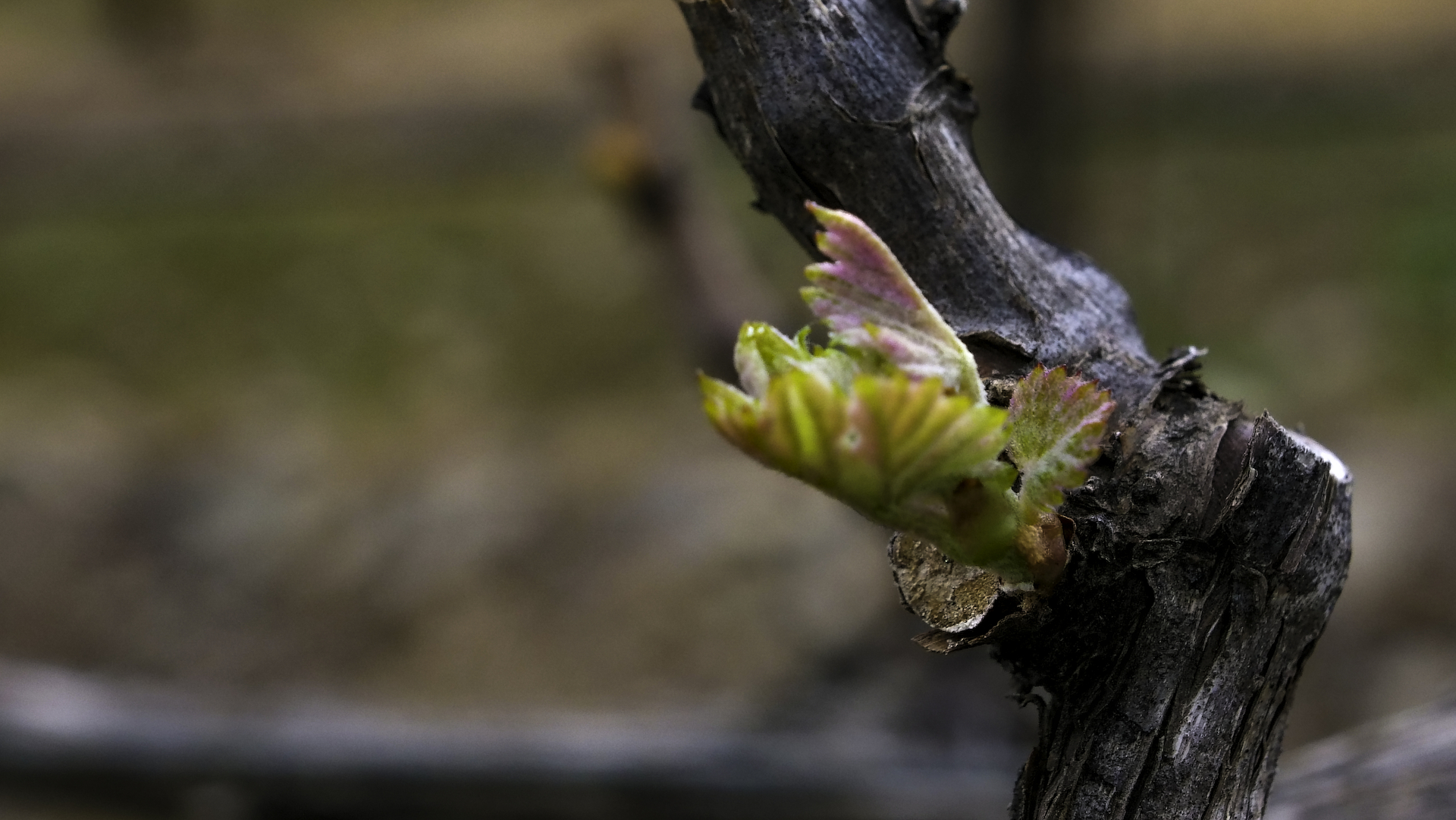
I was shocked to see buds breaking before the middle of March. Typically it happens in mid-April. Juan Carlo did not take his annual trip back to Mexico this year, so pruning started a month earlier than expected; this, combined with warmer weather, has brought an end to dormancy and the start of another vintage. I intentionally delayed pruning the Bayview block until March to push back the bud break. This block often suffers from the brutal wind when the vertical shoots are tender and susceptible to break. All of the images in the clip were taken on the day.
Fragrance and Color in the Vineyard
March 7th, 2022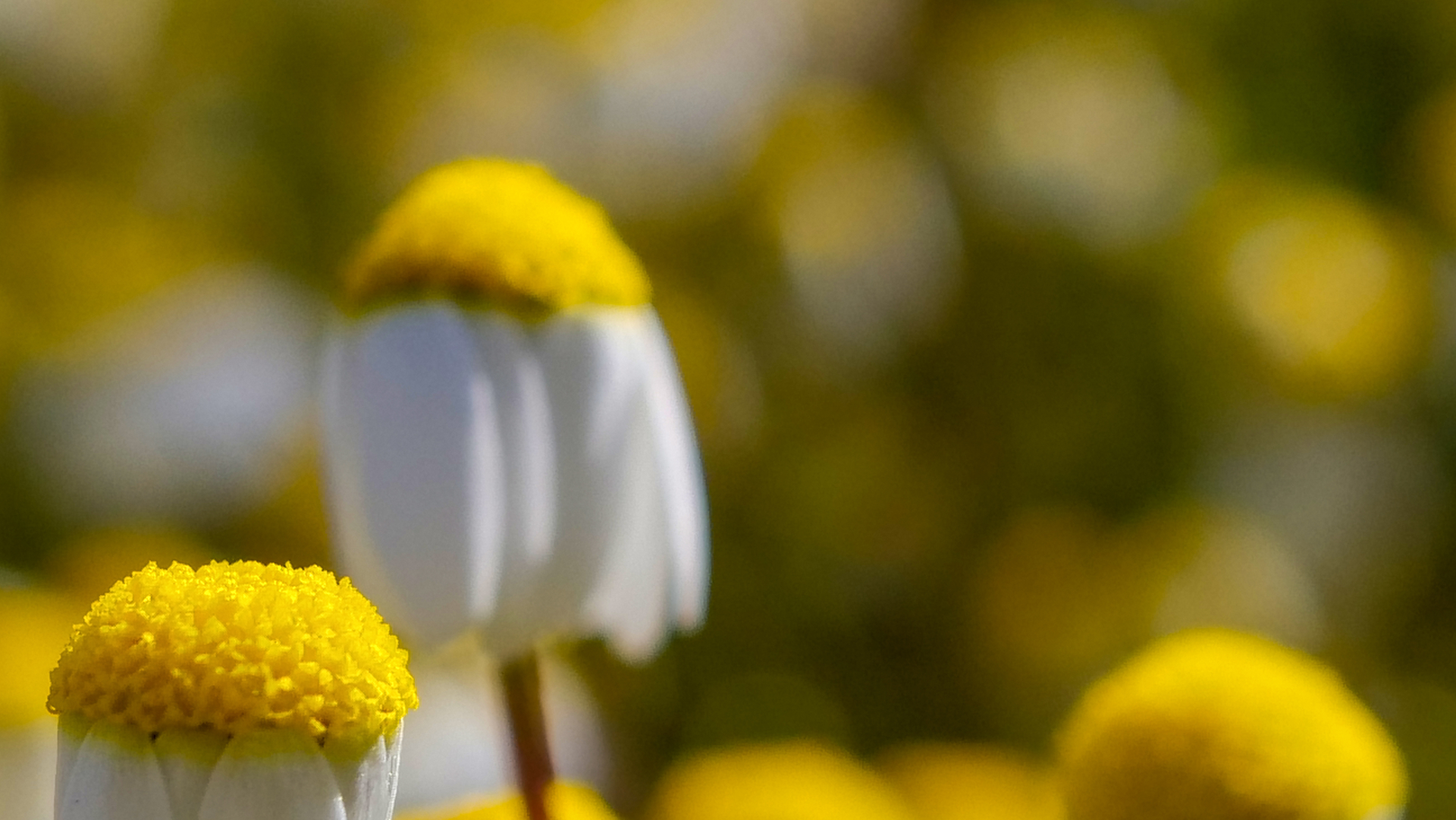
At this time of year, many Napa Valley Vineyards are aglow with brilliant yellow Mustard. Kitoko Vineyard also reflects a warm yellow hue, but its yellow coloring comes from "Chamaemelum Nobile," commonly known as Roman or English Chamomile. In addition to adding color in the dreary season, its pleasant calming fragrance smells like the tea of the same name. It has many acclaimed health benefits, but importantly it attracts insect predators, which help keep the whole ecosystem balanced.
2018 Vintage Release
February 24th, 2022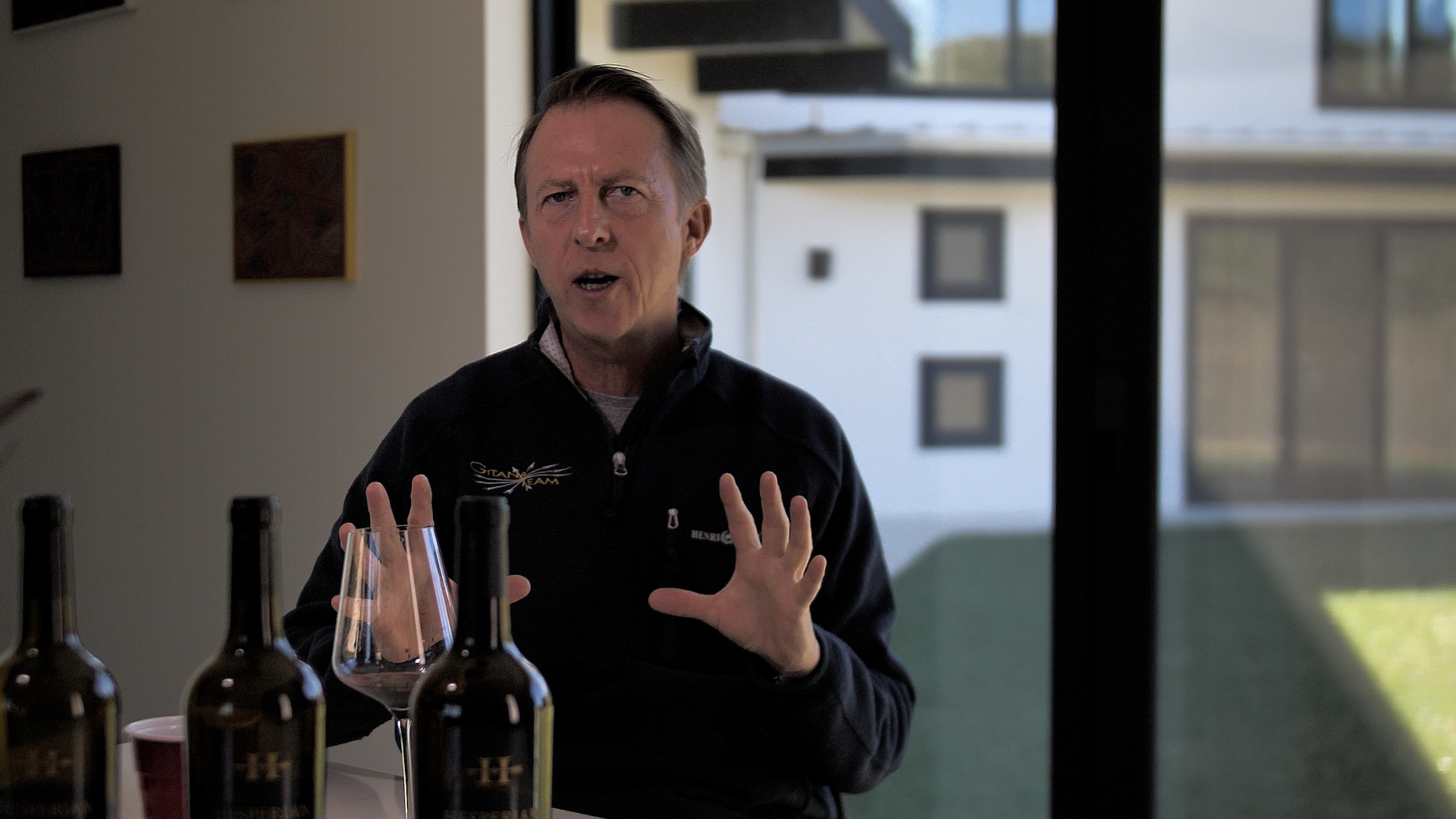
I am excite about the release of the 2018 vintage. To learn why take click on the video and learn more.
Napa Valley's Atlas Peak AVA rebuilds, rebounds
November 6th, 2021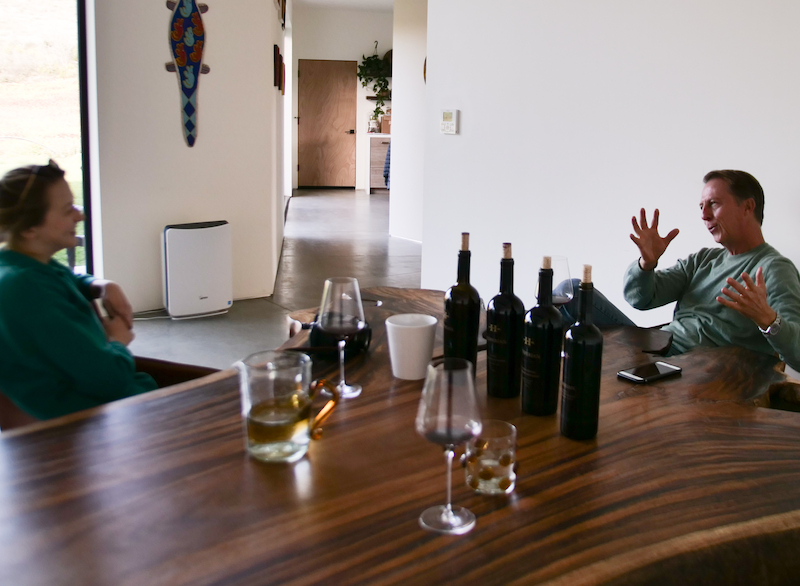
From the Napa Valley Wine Insider Digest: Nov. 13, 2021 series
“When I first came up three weeks after the fire, it looked like half of the vineyard was gone because it singed the leaves,” he said. “When we were able to come up more frequently and we cut into the vine, and we saw it was still green and healthy … For me, that was the most important thing.”
While most of Hesperian’s estate vines were okay, the winery and Langner’s home burned down. Now, his new home is completed — and built of metal and other supposedly fireproof materials — and Hesperian will be digging into the mountain next spring to build the wine cave.
“Now I think, do I need to do this? Should I invest in this thing that might get destroyed?” he said. “Even if the contractor company says they can do this and that to make it fireproof, I just myself, psychologically, cannot handle it … everything will be underground, and we will put in some skylights so they won’t go bananas.”
Taste of Atlas Peak
October 30th, 2021
I was happy to support and be part of the Atlas peak AVA taste of Atlas Peak. In 2021 The AVA stepped up and assumed a lead role in fire prevention and mitigation. They raised over $170,000 to install an early fire detection and responce system, fuel reduction, and fire break creations. Silverado Resort and Spa supported the effort by hosting the most successful Taste of Atlas Peak. Three hundred fifty plus attendees enjoyed sampling wines from 20 Atlas peak wineries and small bites provided by six local restaurants. Besides Atlas Peak wines, the silent auction featured art from locally renowned artists and experience from Napa Valley restaurant's lodging and activity companies
Best Harvest in Years
October 18th, 2021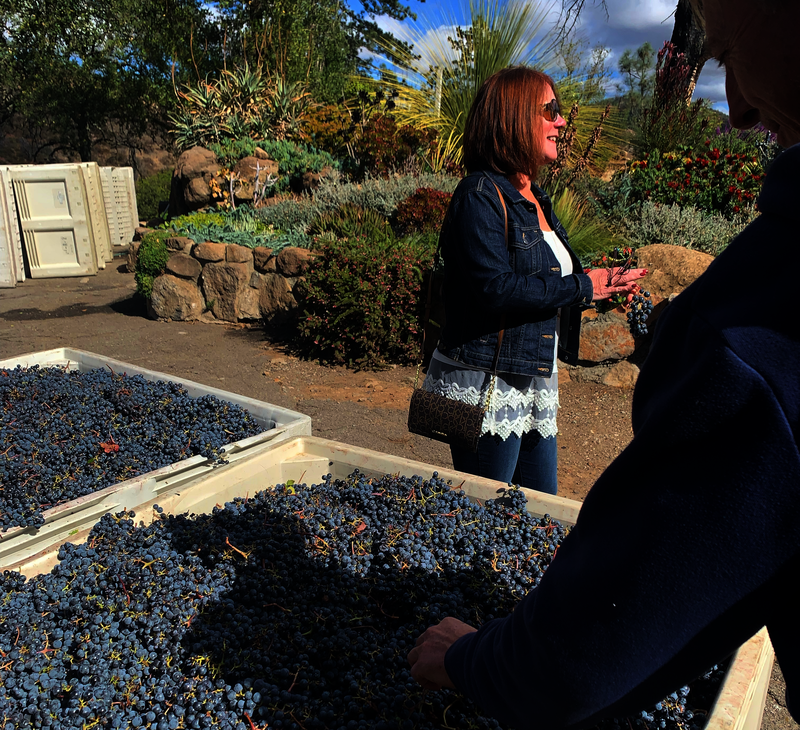
It is always a happy day when the harvest is completed. After five challenging years of draught fire and wind, we finally had what we used to call normal. The weather was good without heat spikes, rain, high winds, or fire threat. It came a few weeks earlier than expected and was completed in 18 days. Still, we had plenty of time to pick individual lots at optimal ripeness spaced at intervals that allowed us to manage fermentation and presses without rushing. Like always, I was able to apply a few new changes to the process that will provide more blending options and result in even better wines.
First Pick
September 30th, 2021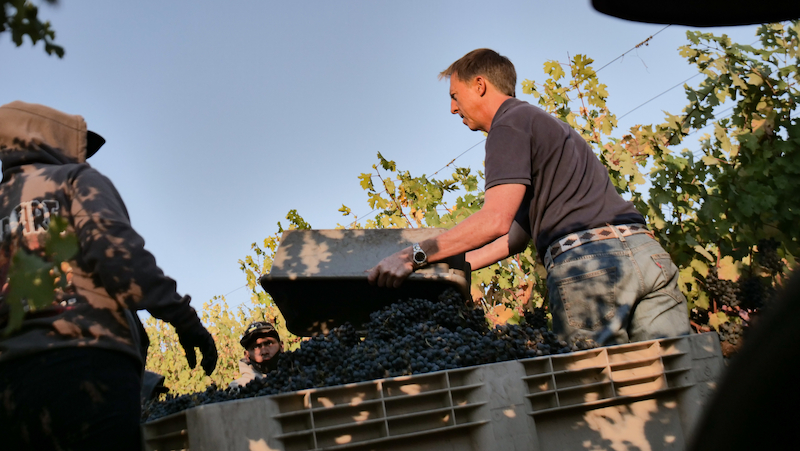
It is unusual for me to Pick in September on Atlas peak, But the grapes ripened a little faster this year, and when they are ready, I pick. We harvested about 1 ton and a half from the top of the block. The weather forecast is for steady temperatures and no rain, so it looks like I will be able to take my time and do small picks as the various blocks reach optimal ripeness. I anticipate being done by mid-October.
Almost to Ready
September 21st, 2021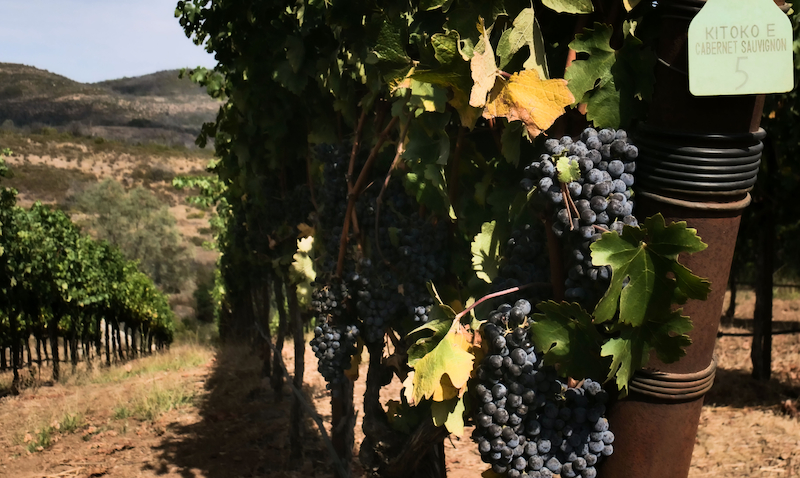
The grapes are coming along nicely, in fact, a little faster than I anticipated. It is to the point that I walk the blocks daily, tasting and expecting how much longer before we start to pick. All of my worrying about fire and having enough water are lessoning. I finished irrigating in early September, and a mid-september light rain dampened down the fire danger. Now it is just waiting until the flavors are optimal. I usually don't start my early pick until October, but this may be different.
Raptor Kite
September 8th, 2021
As the grapes ripen, the sugar levels rise, and the birds gather and feed. I know a healthy ecosystem is best for the vineyard's long-term health, and the birds play an essential part. They help keep insects in balance, but as harvest nears, the berries become so incredibly sweet and delicious that so many birds gather to enjoy them. If I let them feast unchecked, I could lose half of my crop. Also, I wouldn't say I like covering the vine with nets because it is labor-intense and can harm the berries. The air canons, besides being annoying only work for a week before the bird figures out that they are not a real threat. A couple of years back, I saw an ad for kites that look like birds of prey, so I tried one. They work so well that I now have three. I wish all challenges of farming were so easy to solve.
Missing the Sentinels
September 1st, 2021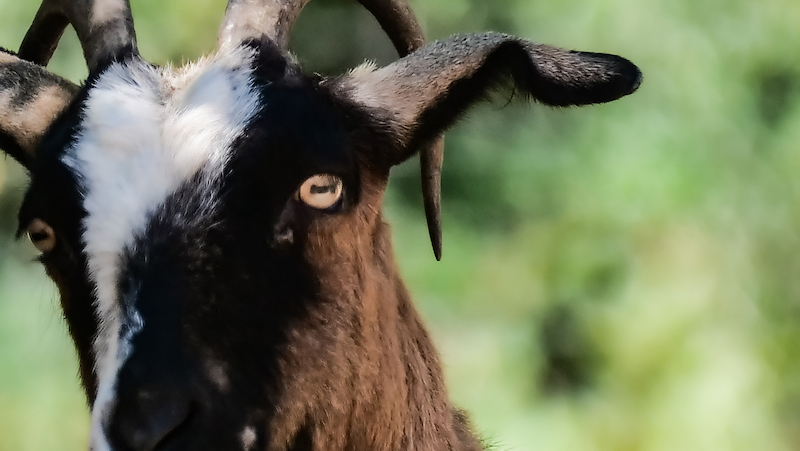
Those who have visited have no doubt see the pair of goats at the entrance to my drive. Although they belong to my neighbor I have I have enjoyed their presence. When they looked lonely, I would sometime stop and pet them. Unfortunately, the white one passed of natural cause in the spring, and I just learned that coyotes burrowed under the fence and killed the one with the stunning brown eyes.
The Grass is Green
August 18th, 2021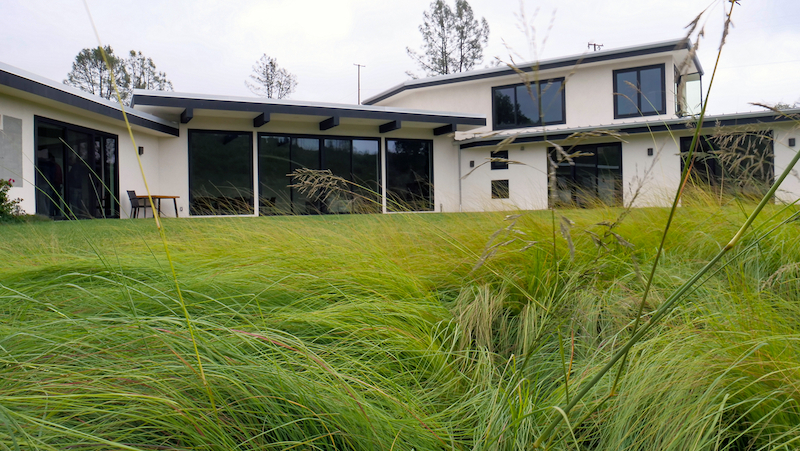
What a difference a year makes. A year ago we were dealing with the threat of nearby fires although the draught is severe the temps have not been as extreme my irrigation system has gotten me through the critical season and the landscaping around my new place.
Happy to be Out and About
August 15th, 2021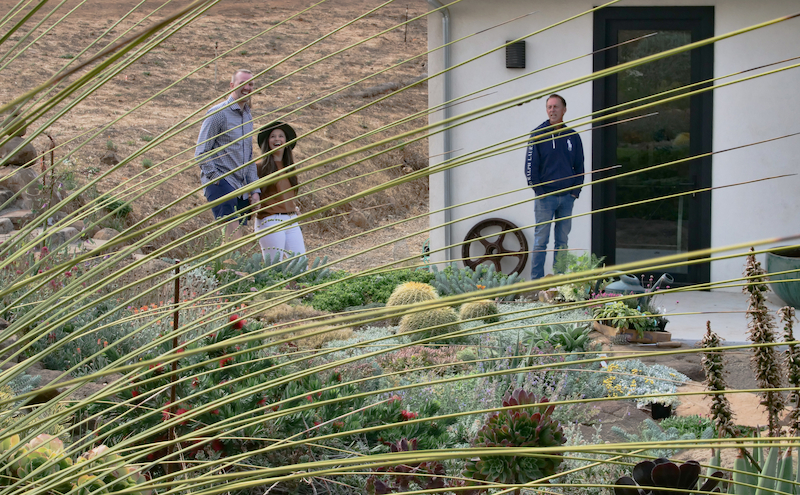
Pent up and feeling the need to be out and about is driving more visitor to my place. It is great to see them open up and enjoy the clean air and amazing views.
Seasonal Visitors
August 10th, 2021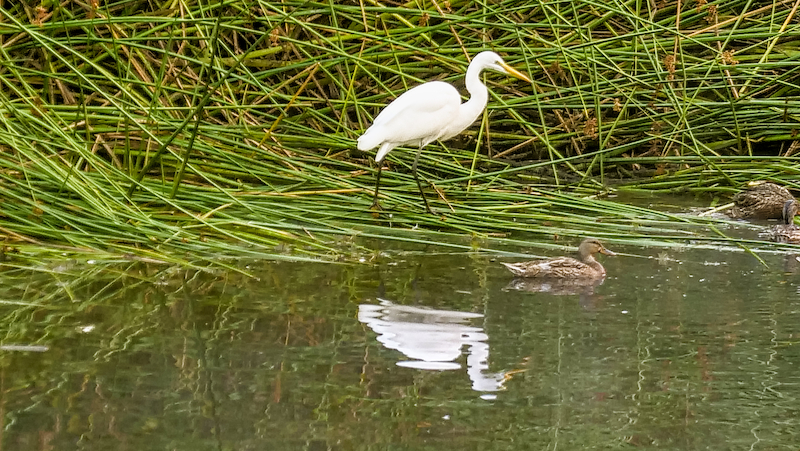
The snowy egret has been hanging around for a couple of weeks. The low lake levels have exposed mud flats rich with food for foraging fowl. Recently the well pump went out, when they replaced it, they were able to determine that water table was still high. This was reassuring news as I have drawn the lake down as much as I can, and all my irrigation is now relying on the well.
It's Looking like a Health Crop
August 2nd, 2021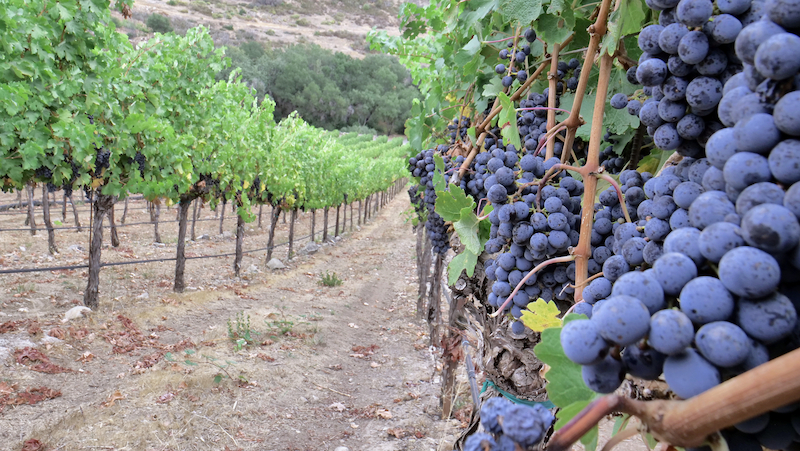
In early July, I was apprehensive about the crop this year. The lack of water had slowed shoot development, and with the lake level, the lowest it had ever been, my vineyard manager was being judicial with what water we had. Luckily, I caught it in time, took the risk, and used what water we had to reinvigorate the vines. They responded well, and now we have a very healthy crop. Barring any significant heat waves, the need for watering should be minimal and well make through with what is in the well and get to harvest in good shape.
Chappell Remnants
July 14th, 2021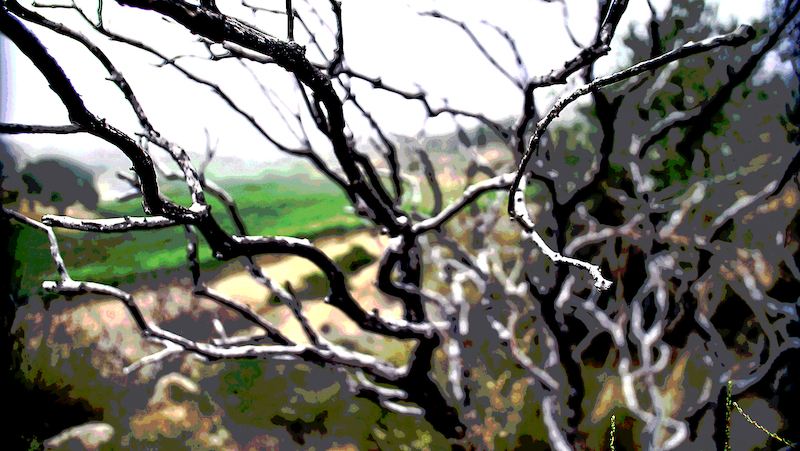
For six months a year, Atlas Peak is a high rocky desert, replete with flora and fauna well adapted to fire. Until 50 years ago, regular burns reduced fuel loads and prevented fires from completely decimating the landscape. Three generations of intervention coupled with a warming climate have resulted in higher winds, extended droughts, and a build-up of fuels that have supercharged the intensity of fire impact. This burned remnant of manzanita is an eerie reminder of recent results.
I am worried about water
July 8th, 2021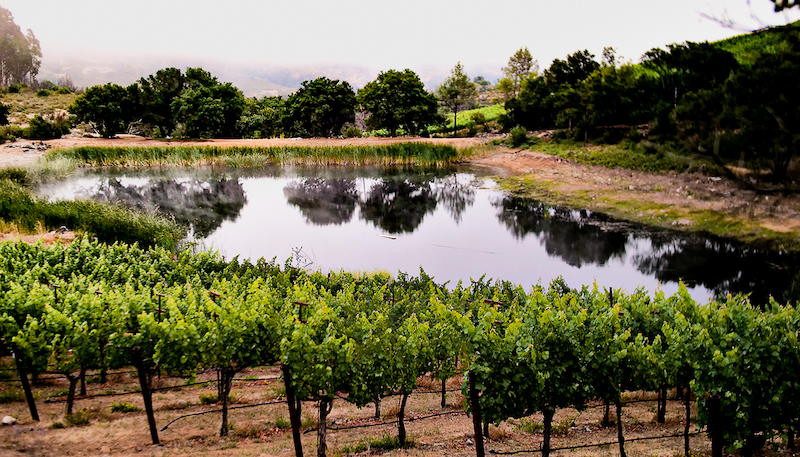
This year is the first since I have been here that the lake did not spill over. As I learn the nuances of the vineyard, I find that with an irrigation regime that starts in April, I get a healthier canopy, better set, and fruit that matures sooner. In our current extreme drought conditions, the vines need more water, and I have less. My reservoir is nearly empty, and it is only mid-July.
Morning Glow
June 24th, 2021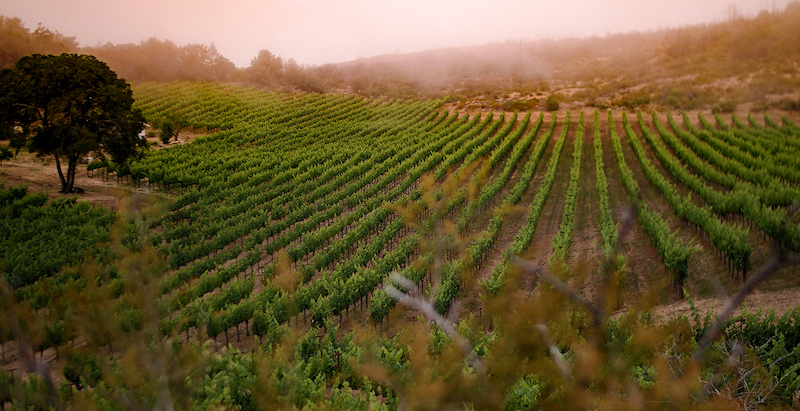
The morning glow created by the rising sun and lifting fog adds vibrance to the serenity of the vineyard. Not being a morning person, I am grateful when the many farming tasks require an early start reward me with such light.
Atlas Peak Association
June 19th, 2020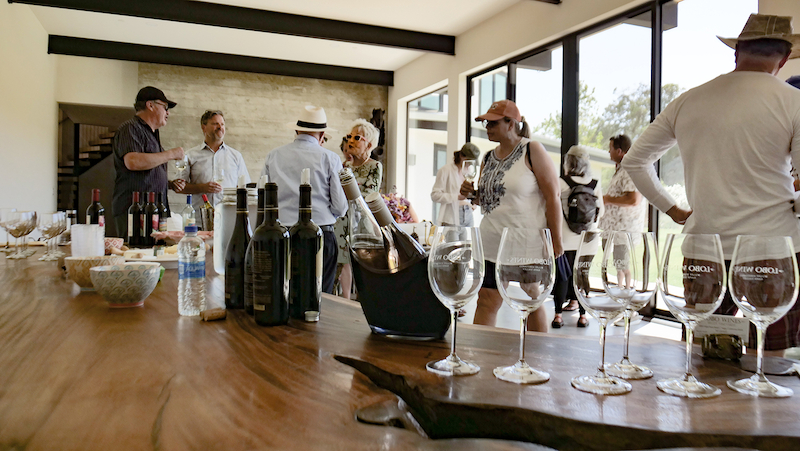
After being in my new house for a year, I can finally host Friends and Neighbors of the Atlas Peak AVA Association. It was great to share wine, get reacquainted and meet new members.
The Adventure Begins
June 3rd, 2021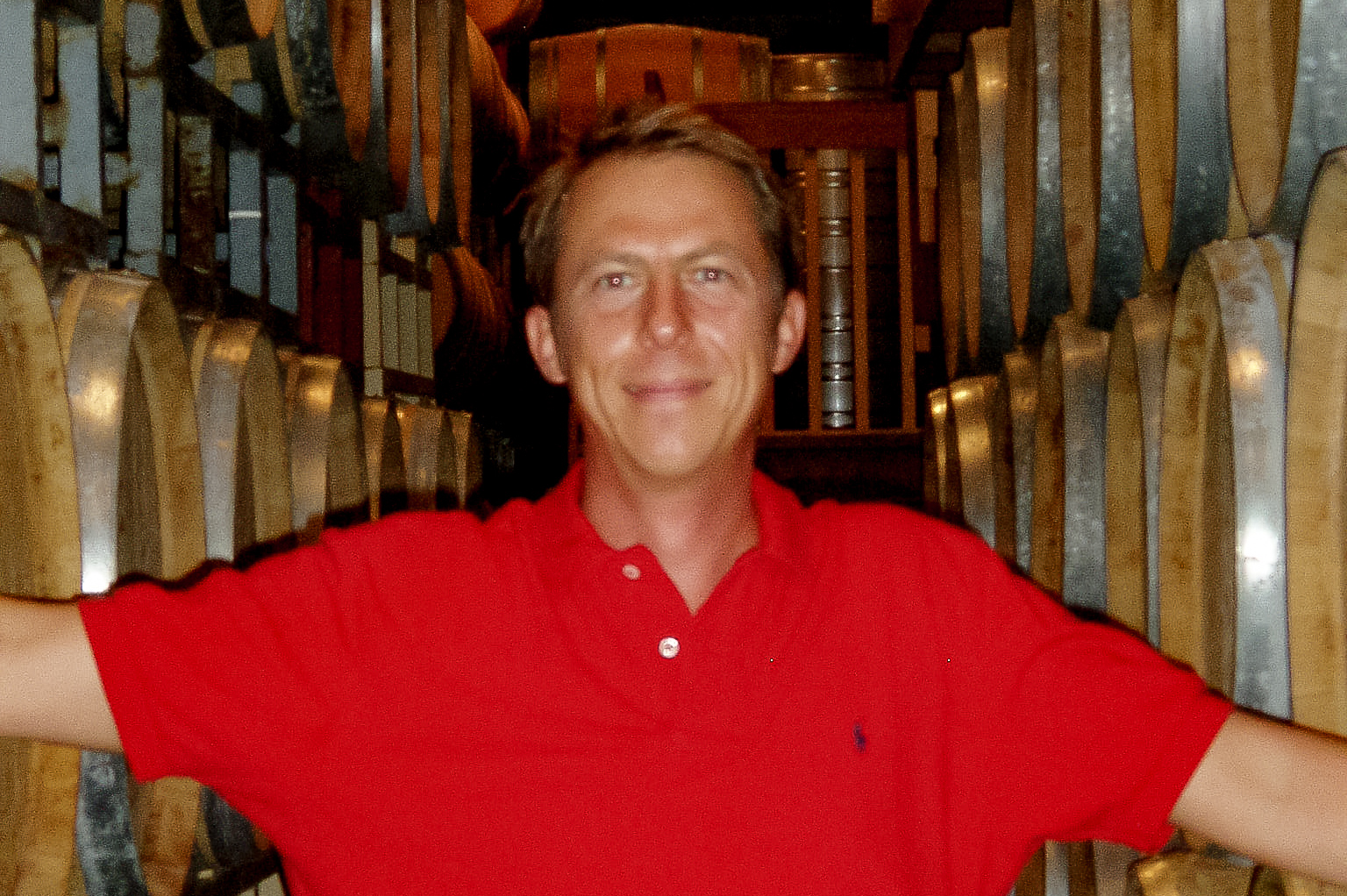
Yes that is me 17 years ago when I was rambunctious and ready to prove to the world that I could make world class, age-worthy wines. In this clip I share the story of how it all , began and review the 2004 Harry's Vineyard Cabernet Sauvignon to see how it has stood the test of time.
Story behind the totem
May 27th, 2021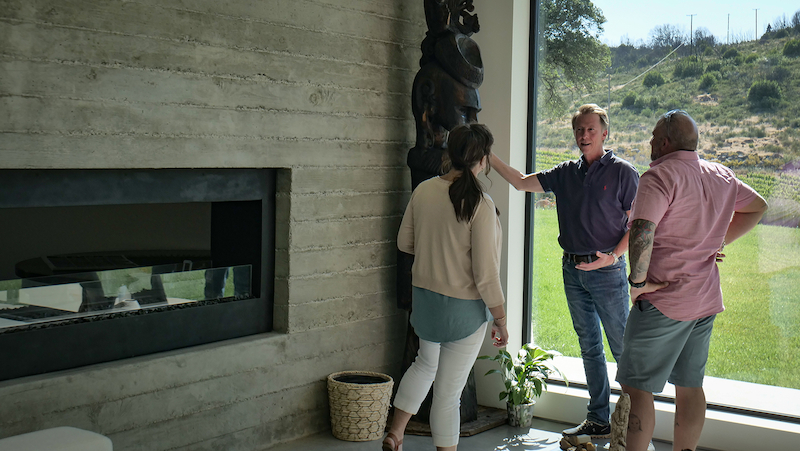
For over a year I have been in my new house but only now am I able to share it with guest. Here I am telling the story about how in 2014 I visited Bali and found the prices so reasonable that I ended up filling a small shipping container with art and furniture. Unfortunately, the only two things that survived the 2017 fire were too big to fit in my old house. This totem was only 15 feet from the house but for some reason it did not burn.
New Vine progress
May 22nd, 2021
It is has only been six weeks since we planted the dry bare root sticks and already they have grown 18 inches with leaves poking out of their protective sleeves.
Vineyard management in a draught
May 15th, 2021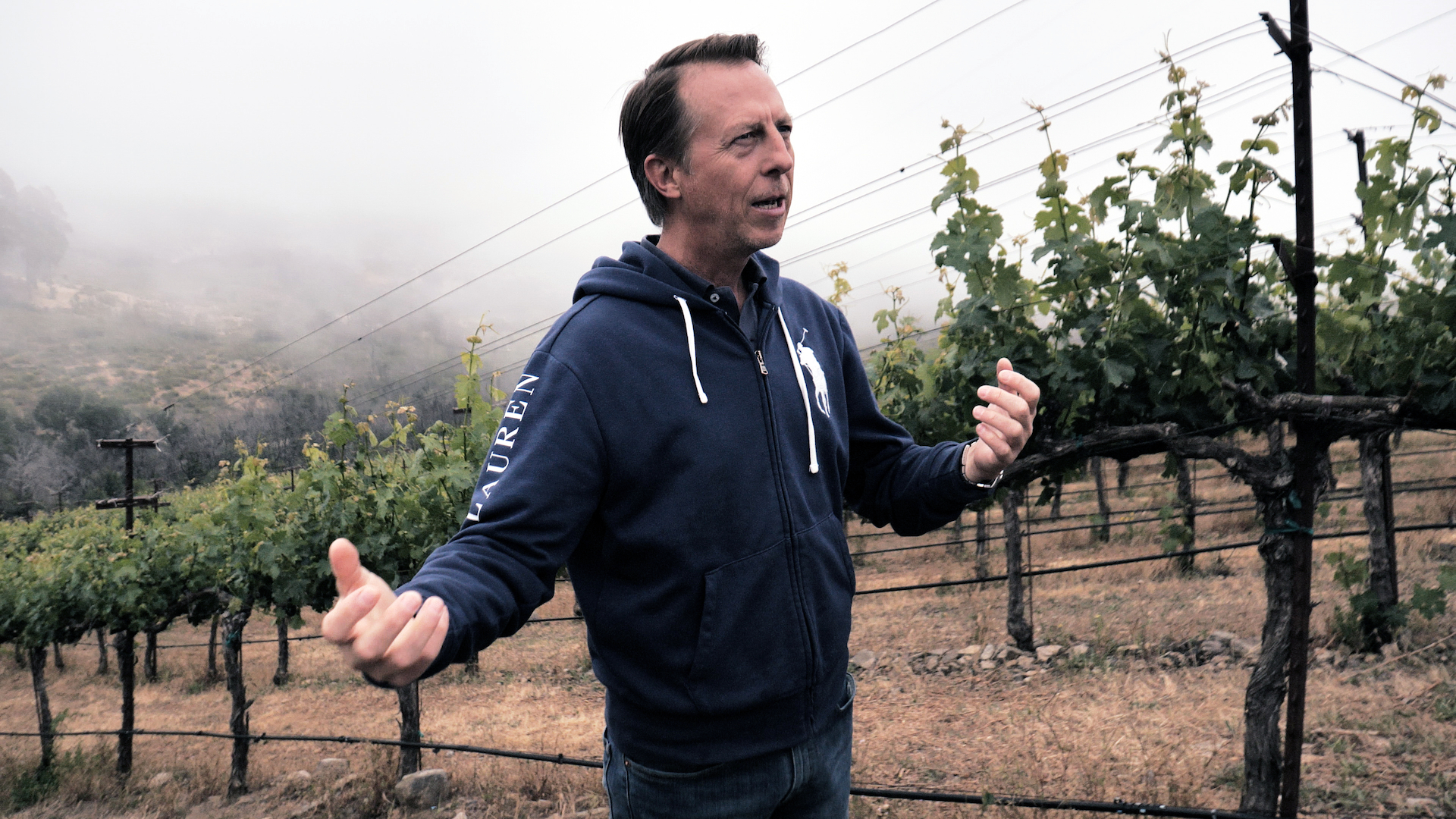
Click on the image to watch Philippe Langner describe and demonstrate the early season vine management practices he is implementing in this draught year. These changes will help to conserve water and insure the vines concentrate their energy on producing the best possible fruit.
Spring Flowers
May 10th, 2021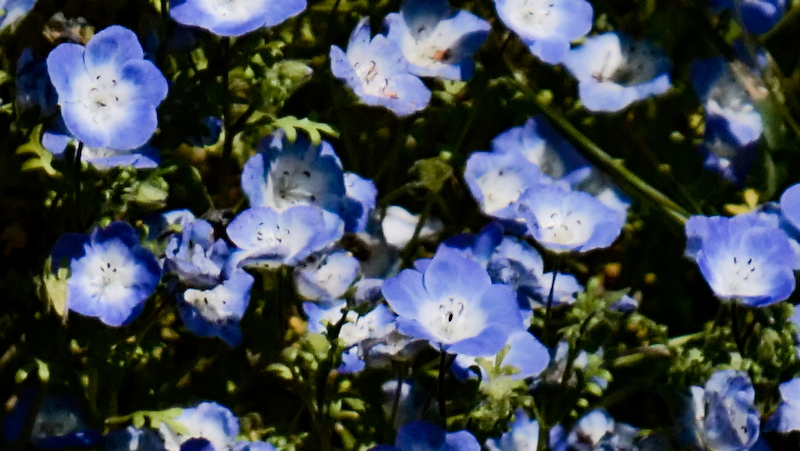
Although the lack of rain this winter has me deeply concerned I have to say that the flower gardens are exceptionally vibrant this year. The Menzies Baby Blue Eyes is one of my favorite native California species. It is prolific from the Baja to norther California. The Botanical name is Nemophila menziesii named after Scottish botanist Archibald Menzies who traveled aboard the HMS Discovery with George Vancouver on his exploration of the west coast from 1791-1795.
Current Line Up
May 4th, 2021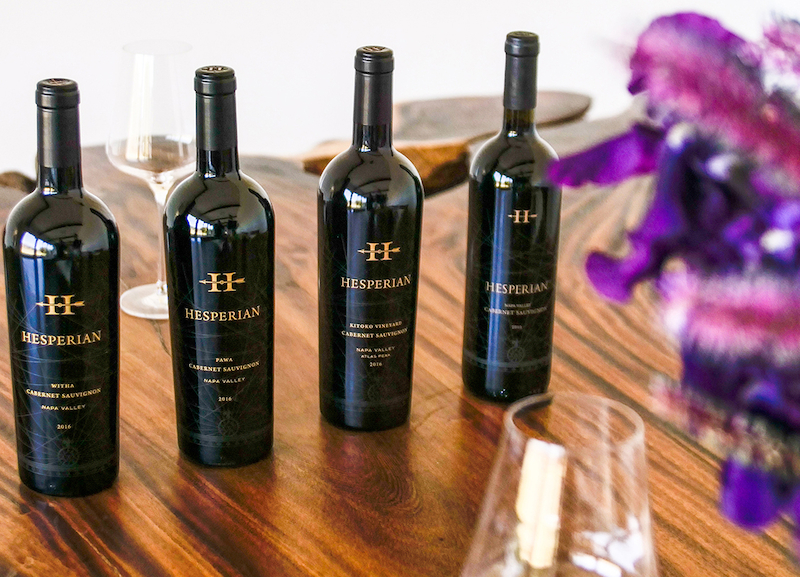
It is hard to believe it has been 15 years since the first vintage of Hesperian. Much had changed, and then much is still the same. Although the trend shifted to big fruity easy-to-drink reds before 2004 I stayed with what I learned in Bordeaux. It wasn't received well by a critic so I decided to cellar it until it settled down and became the wine it was intended to be. Now when I taste 2004 I am very pleased that decided not to push it on a market that wasn't ready for age-worth wines. Since 2004 I have learned much still yet I still rely on my training from Bordeaux for my winemaking techniques. I experimented in farming practices, with ripeness levels, watering regimes, and pruning to develop wines that drink well when they are 5 years old but will still hold for 20 more years. My 2016 wines are a representation of this progress.
Alone In the Vineyard
April 15th, 2021
This is my favorite time of year, the vineyard is about to come alive yet, I still have time to relax and enjoy the views from my living room. Soon things will become very active with suckering, mowing, spraying, lifting, and trimming the vines. This year's large cluster count and extreme drought will add extra work. Typically when the new shoots are 6-12 'inches tall we remove those that do not have 2 or more grape clusters but, this year we started early in an attempt to conserve water and better concentrate the energy into the best shoots. Because we are doing it early it will require that it be done one or two more times as the new shoot will replace the one we remove.
For the Love of Growing
April 10th, 2021
I was very fortunate that at an early age my mother recognized and supported my love of growing plants. At age 6 she gave a 10' x 10' plot that I could do whatever I wished. Being in Africa where succulents were varied and abundant and easy to propagate I couldn't wait to get out of school to see the new developments in my plot. When I moved up to Atlas Peak I resumed my plot which features any species from around the world, this year I added several strange-looking succulents, one of which is the octopus agave from Mexico featured in the photo.
Happy ...New Vines
April 7th, 2021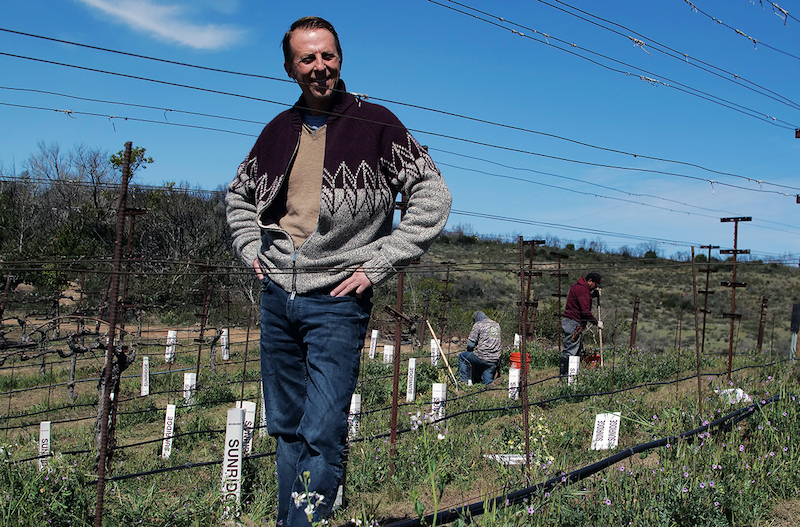
As you can probably tell by the photo that I am very happy to be finally replacing the vines that were lost in the fire. I was surprised when the count ended up being over 700 new plants. It will take several years before they produce grapes good enough to use in my wines but, that is part of farming. The cycles are long and it takes patience to realize the fruits of your labor, But in the end, I find it extremely satisfying.
Chamomile not Mustard
March 25th, 2021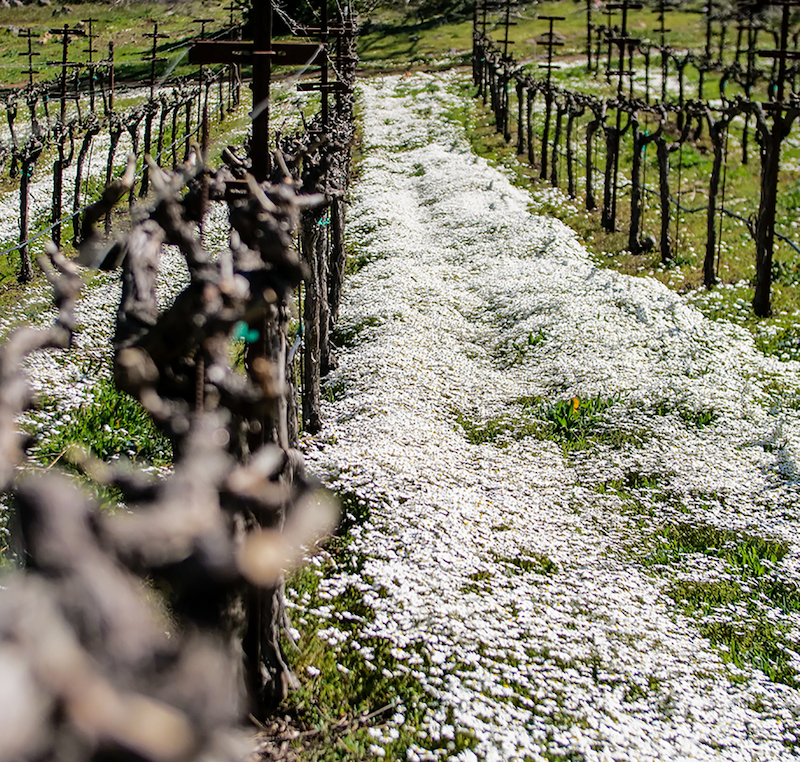
At this time of year Napa Valley is known for it's brilliant yellow mustard growing between the vines. However, up here at Kitoko Vineyard my rows are filled with fragrant white chamomile. I didn't plant it, it just appeared and each year it becomes more abundant. Being a bit of an individualist, it suits me well.
New Beginnings Happen at Kitoko Vineyard
March 11th, 2021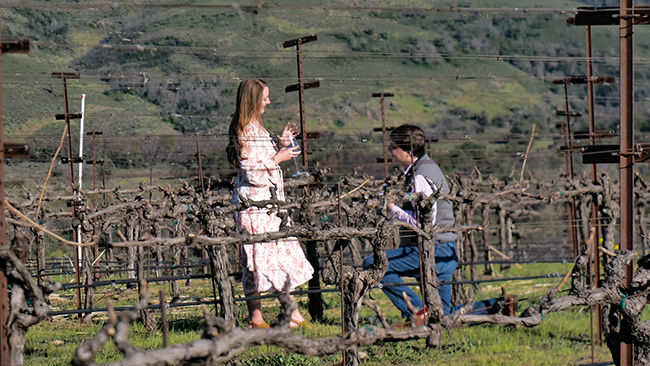
After a long year, this spring is bringing with it hope and new beginnings. When I discovered the vineyard, it was called Last Chance. But, for me it was a beautiful new beginning, so I chose a new name from my childhood. In Zaire where I spent my most formative years the word Kitoko means beautiful. I am honored that others enjoy its’ beauty and use it as a place to propose new beginnings for their lives as well.
Tasting Review of 2016 Pawa, Witha & Kitoko
February 22nd, 2021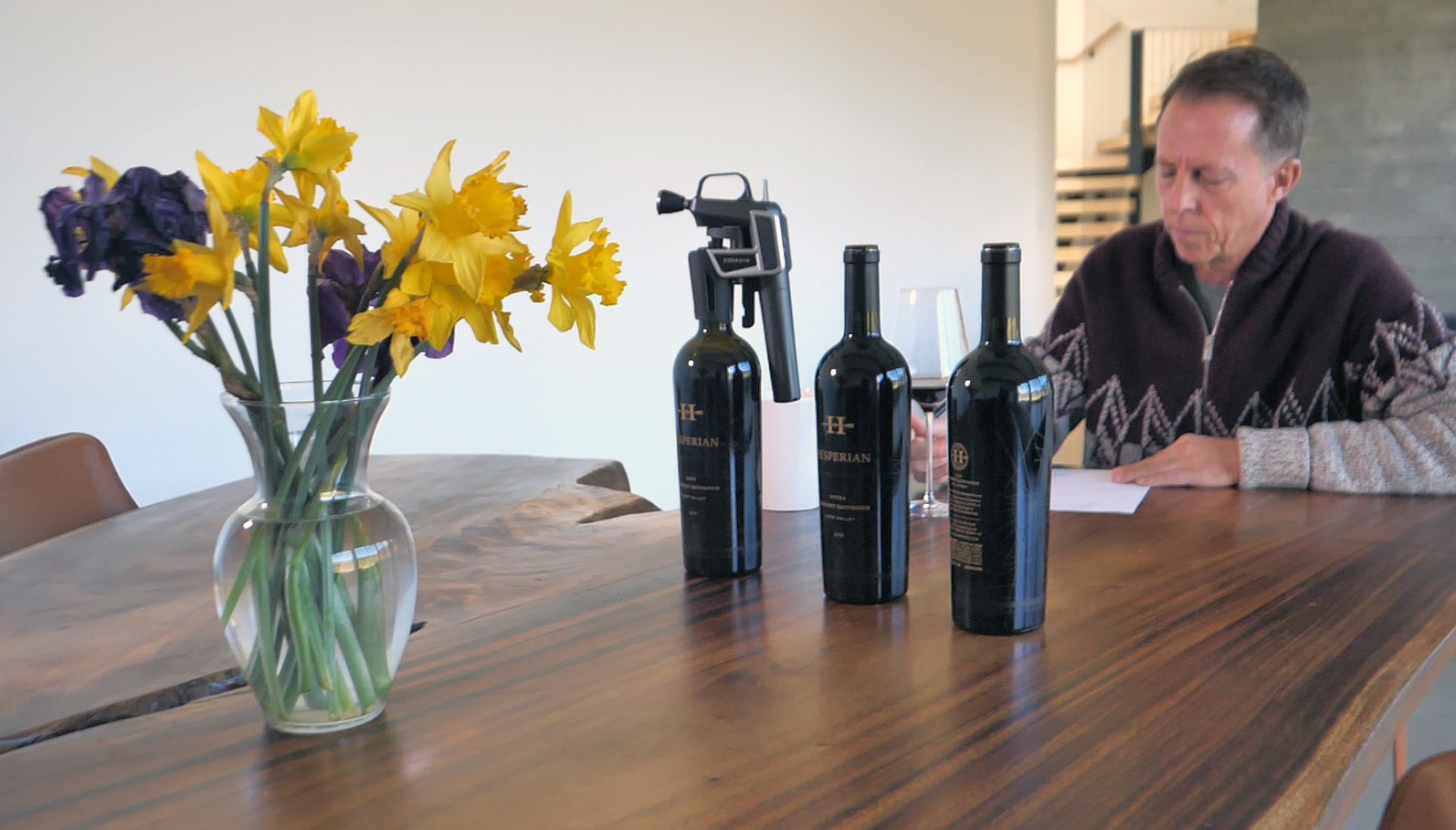
In 2016 Hesperian Wines expands it offering to three wines made from blends of different ripeness picks and fruit from 3 vineyards. Join Philippe as he taste through the wines and shares his sensual perceptions of each wine.
Seasonal Visitors
February 15th, 2021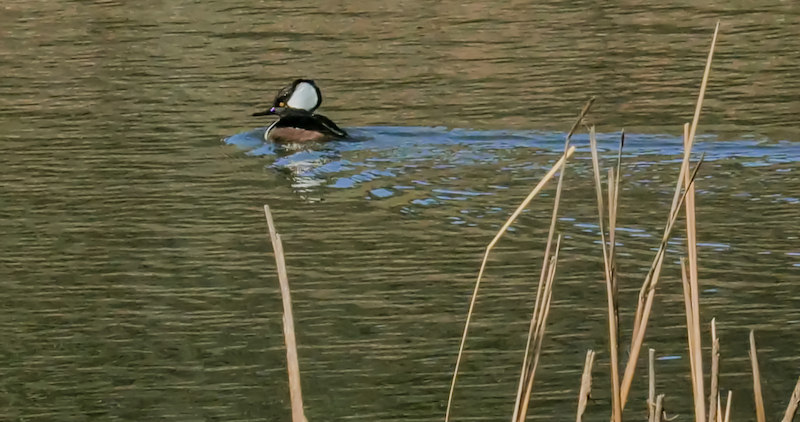
The lake in the middle of the Kitoko vineyard is the source for irrigating the vines on the lower half of the Vineyard. Equally important it provides diverse habitats for a healthy environment. I like to say my wines are 80% made in the vineyard. When I encourage and nourish a balanced ecosystem the vines thrive and reward me with exceptional fruit. Part of the balance comes from a diversity of plant insects birds and animals that live on the property. It is encouraging and pleasurable to see the many species of migratory birds stopping by. Last month it was a brood of Bufflehead ducks.
Blending the 2019 Kitoko Vineyard Cabernet
February 5th, 2021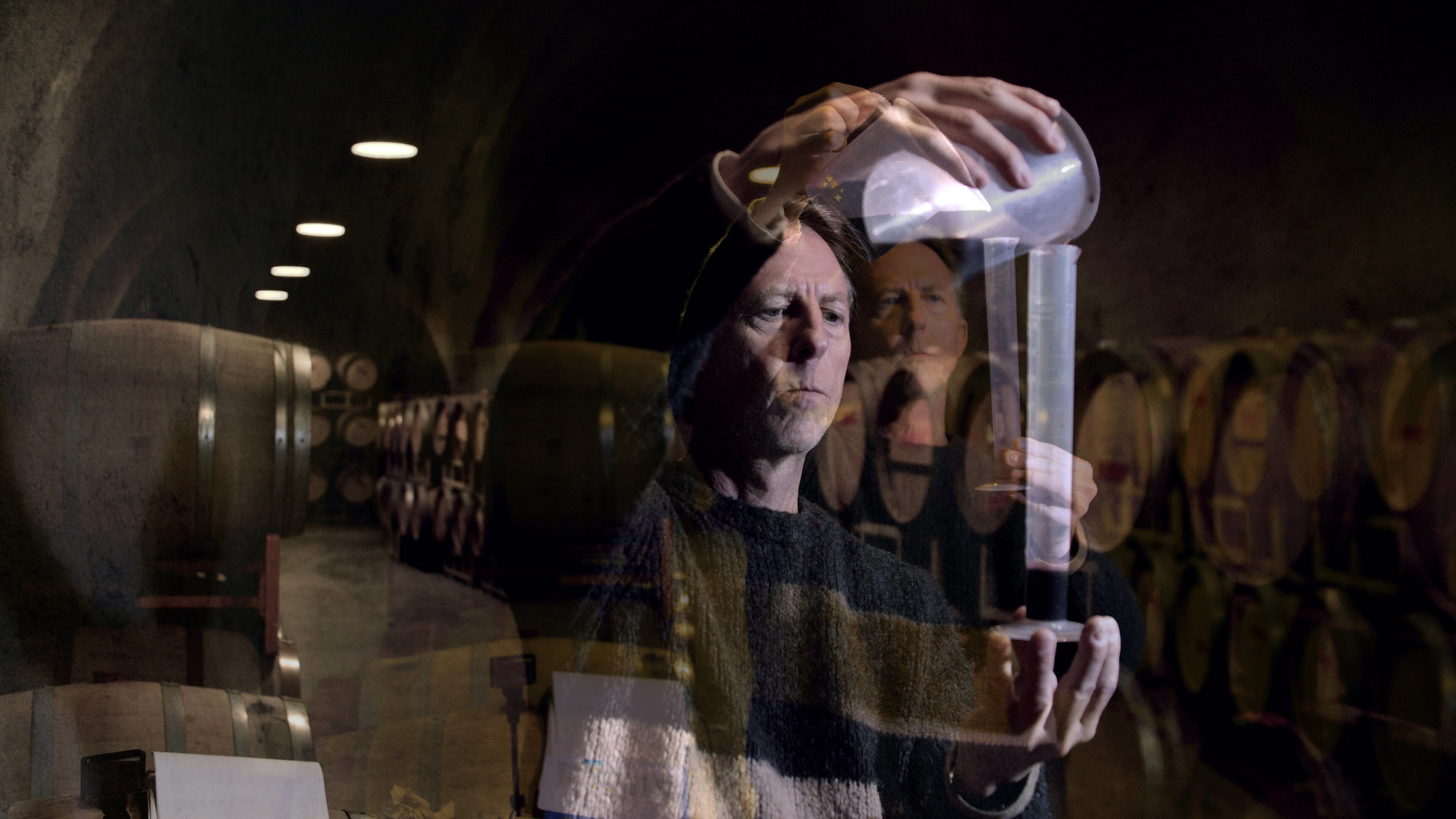
Philippe takes you into the caves where he ages his wine and does the annual blending of the Kitoko Vineyard Cabernet Sauvignon. Watch and learn as he collects samples from different barrels and experiments with different formulas until he settles on the final blend.
The 2016 Release brings a new wine
February 1st, 2021
The 2016 release introduces the Witha and Pawa labels to Hesperian Wines. For 20 years Philippe has focused on making age-worthy Napa Cabs that showcase the terroir of various vineyards located in the Napa Valley. Two years after acquiring (in 2010) and improving the vineyard, Kitoko Vineyard, Atlas Peak AVA, he introduced his ultra-premium Kitoko Vineyard label. It was made of the best lots from its namesake vineyard. With six years of vineyard improvements in place Philippe was ready to turn his attention to individualized management and harvesting of specific lots at different ripeness levels. The intention was to produce a 100% Cabernet Sauvignon that could be enjoyed upon release, yet possessed characteristics of classic, age worthy, collectable wines. The 2016 vintage is the first to incorporate the integration of various ripeness levels in his 100% Cabs. To distinguish this new dimension to his winemaking he introduced two new names/label. The 2016 is also the first vintage of Hesperian Wines to be held for 5 years before releasing to the public.
2016 Hesperian Kitoko is little changed and made up of the best of the late picked grapes from his best lots from the 14 acres of his vineyard. The thin, rocky soils of Atlas Peak force the vines to struggle resulting in intense wines with durable super fine tannins that allow the wine to drink well from release and also for the next 20 years.
2016 Hesperian Witha formerly called Hesperian Napa Cabernet Sauvignon is now comprised of the early picks from the Kitoko vineyard and the Upstream Vineyard located east of Napa in the Coombsville AVA. Philippe has leased and farmed the Upstream vineyard for six years. This elegant wine is a true classic with fine tannins that will age 30 years or longer. Witha is a Wappo Indian word for West.
2016 Hesperian Pawa Is a completely new wine for Hesperian Wine. It is made up of the middle ripeness picks from Kitoko vineyard and Didier Vineyard located in the Napa AVA. This wine is full of plush fruit and has a round mouthfeel. This wine is drinking exceptionally well now and will continue to do so for at least 10 more years. Pawa is a Wappo Indian word for One (one wine made from the blend of a few vineyards).
Fascinating Journey in Life
January 20th, 2021
Steven Rea
My guest today is Philippe Langner, someone who has a love of life, people and an adventurous spirit which will put a smile on your face. He’s the Owner and Winemaker of Hesperian Wines on Atlas Peak in Napa Valley.
Of French descent, his journey started growing up in Africa, where, when his parents weren’t working, they’d take the family 10 hours by boat and jeep into the bush where they chose to live and enjoy their time off. Philippe shares how such experiences living so far from any aid or assistance helped form his character including his innate ability to accept and deal with severe challenges in life.
Listening to Philippe, one can’t help but feel his infectious love of life, people, passion for growing things and his free spiritedness.
He has relations with the Rothschild family, has worked in and seen success in the world of finance, yet he just couldn’t sit still and be content in his corporate, indoor office.
In our conversation you’ll hear his fascinating journey and get to know his wonderful character that is embodied in his estate and Hesperian wines he crafts.
I hope you enjoy it as much as I did.
Despite setbacks, Philippe Langner keeps producing great wine
January 10th, 2021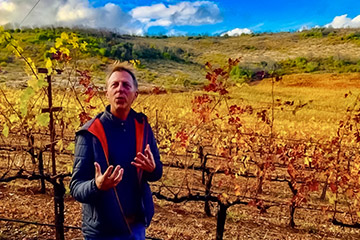
LYLE NORTON: San Francisco Examiner
Philippe Langner is a true vigneron. He is the owner, sole viticulturist and winemaker for Hesperian Wines, controlling all aspects in the production of his highly reviewed cabernet sauvignon releases, from bud break to bottle. The primary source of his fruit comes from the picturesque 14-acre Kitoko Vineyard spread across slopes outside the large windows in his new home. Philippe has chosen this remote, serene place high up on Atlas Peak to live and follow his life’s quest.
Born in El Salvador, raised in Colombia and the former Zaire in Africa, Philippe has a passion for plants and soil that began at an early age. Pursuit of a career in agriculture led him to University of California, Davis where he was introduced to the Napa Valley. After college, he spent five years working at a Bordeaux chateau in France before opportunities and the warm climate pulled him back to Napa.
While working as viticulturist and winemaker at historic Sullivan Vineyards in Rutherford, Philippe took a risk, secured some cabernet sauvignon grapes from a Coombsville vineyard and initiated the Hesperian brand. Within a short time, he committed to the mountain property and his calling to create the model Napa Valley cabernet sauvignon.
The 14.2 acres of steep, neglected vines, once known as the Second Chance Vineyard, is what attracted Philippe to the parcel. He envisioned something different. Renaming it Kitoko, the Congolese Lingala word for beautiful, he skillfully transformed it to one that produces consistent low yield, high quality fruit.
Philippe also demonstrated some culinary skills as he prepared a gourmet lunch at his home. It was during lunch that I first understood his passion and resiliency as a true vigneron.
Philippe lost his original home during the 2017 Tubbs fire that ravished the valley and parts of Sonoma County. Shortly after his new home was completed, the recent Glass Fire left the vineyard intact but exposed the grapes to smoke taint. After some trepidation, he decided to drop all the tainted fruit and forego a 2020 vintage.
After months of meticulous work and care in the vineyard, it must have been devastating for him to drop the fruits of his labor. However, I didn’t see or hear that in his attitude. During an afternoon walk in the vineyard, Philippe spoke enthusiastically about the next vintage, the qualities of the individual blocks and of improvements that would result in more perfect fruit.
The Hesperian name relates to the West, but this story is about one man’s passion for perfection and a desire to influence each phase of the process in setting a standard for Napa Valley cabernet sauvignon. I was more than willing to taste his new vintage 2016 releases.
The unique location of the Kitoko Vineyard enables grapes to ripen at different times, something described as “shatter.” As a result, the wine in 285 cases of the flagship 2016 Hesperian Cabernet Sauvignon Kitoko Vineyard Atlas Creek ($150) is made from low-yield vines. Captivating aromas precede a luscious mouthfeel with dark fruit flavors and spice notes throughout he finish. This Kitoko Vineyard release is the only in Philippe’s collection with an alcohol level above 14%.
Early ripening grapes in the Kitoko Vineyard are combined with fruit from the Upstream Vineyard in the Coombsville appellation, southeast of Napa, to produce the rich, full-bodied 2016 Hesperian Cabernet Sauvignon “Witha” Napa Valley ($100). Aged 20 months in 31% new French oak, the flavors are more fruit-driven with herbal hints throughout.
Fewer than 200 cases of the 2016 Hesperian Cabernet Sauvignon “Pawa” Napa Valley ($100) were produced, combining grapes from the Kitoko Vineyard with the best barrels of nearby Eagle’s Nest Vineyard. Aged 20 months in 25% new French oak with more time in the bottle before release, this wine has an excellent flavor profile and is an expression of terroir.
Determined to create a more affordable cabernet sauvignon, Philippe launched the Anatomy No. 1 brand in 2006. Medium-bodied and produced in the Bordeaux-style, the 2016 Anatomy No. 1 Cabernet Sauvignon Napa Valley ($45) is sourced from multiple vineyards and expresses ripened dark fruit flavors with smoky spice notes.
The Wine Serendipity and Resilience of Philippe Langner
December 20th, 2020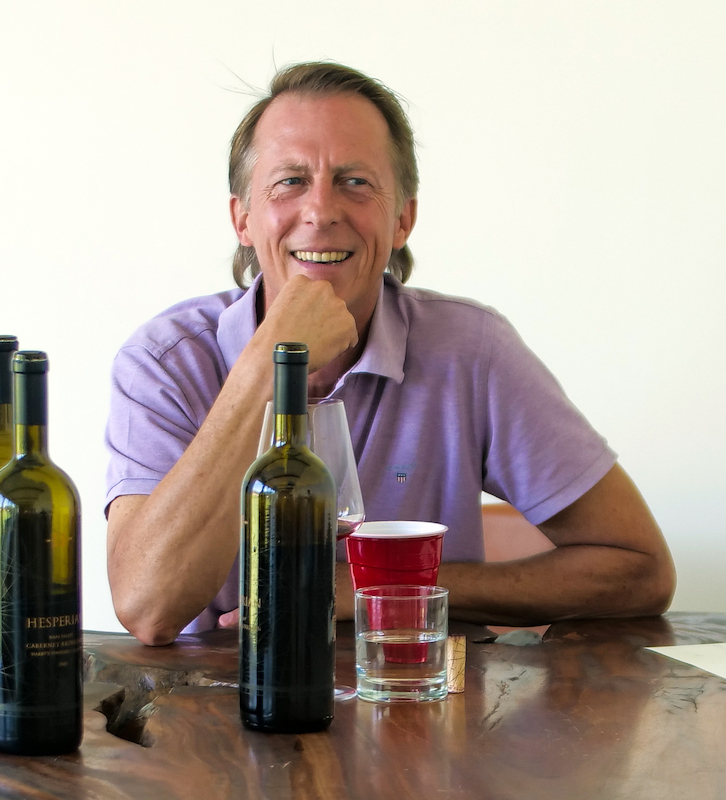
Philippe Langner's life has been full of surprises, some good and others not so fortunate.
Today he is a master viticulturist and lauded winemaker for two successful brands in the Napa Valley, but it was serendipity that got him into the wine business almost twenty-five years ago. An internship in Bordeaux evolved into a lifelong learning process. And it all started with the farming.
Philippe is a vigneron in command of two distinct labels. Hesperian aspires for the highest perch for Napa Valley Cabernet Sauvignon. Those bottles evoke the vineyards from which they are grown and exhibit precision and finesse. Critics have applauded Hesperian wines vintage to vintage with lofty scores. Philippe is not satisfied. His desire to learn more, experiment, and better express his vineyards drives him. READ MORE
Happy Holidays
December 19th, 2020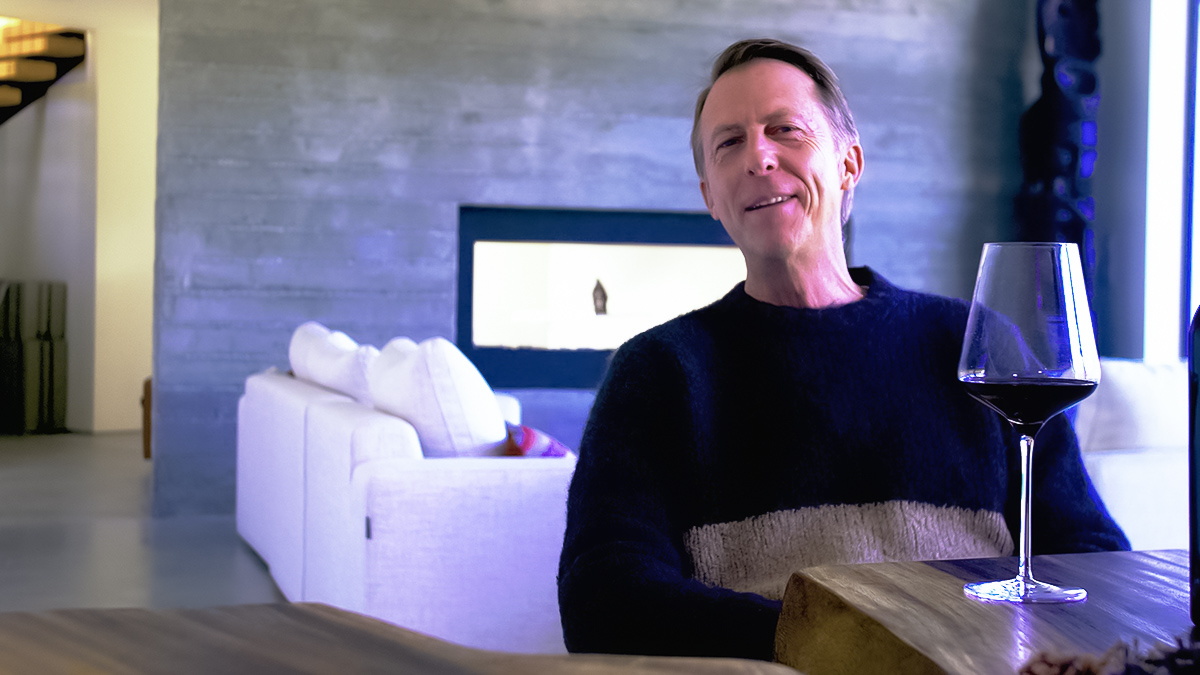
Although 2020 has been a year of many challenges, but recent developments leave me hopeful for a brighter 2021. Click on the image to see my short summary.
Dropping Smoke Tainted Fruit
October 3rd, 2020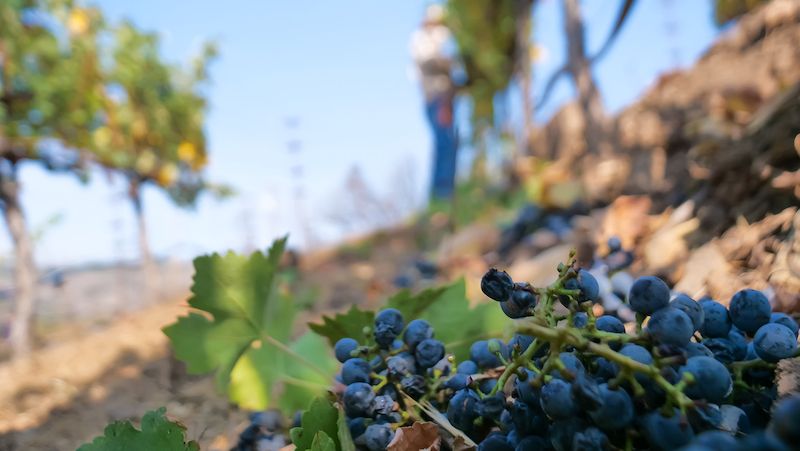
Lab results confirmed that the smoke has tainted the 2020 Kitoko vineyard. It is hard to throw such a beautiful vintage away but it is best to drop it to the ground putting nutrients back into the soil, reducing irrigation and allowing the vines to go dormant.
Crushing Eagles Nest and Upstream Cabernet Sauvignon
September 30th, 2020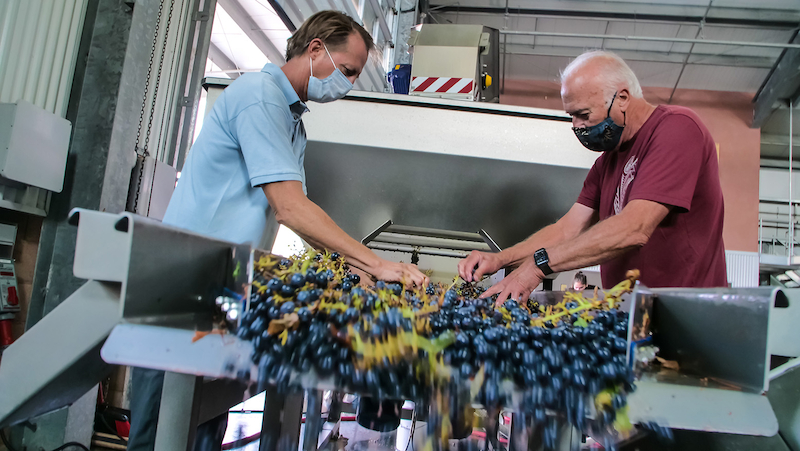
I had planned to harvest the Cabernet Sauvignon grapes from the two other small vineyards I lease and manage this Friday, but with the Glass Fire only 17 mile north I took advantage of a few cool days to pick, crush and get it in tank before things changed. The fires have the roads blocked to the vineyard where I usually crush and make my wine, luckily it was less than 20 tons total and the kind folks at Ceja winery made space for me.
Testing for Smoke Taint
September 13th, 2020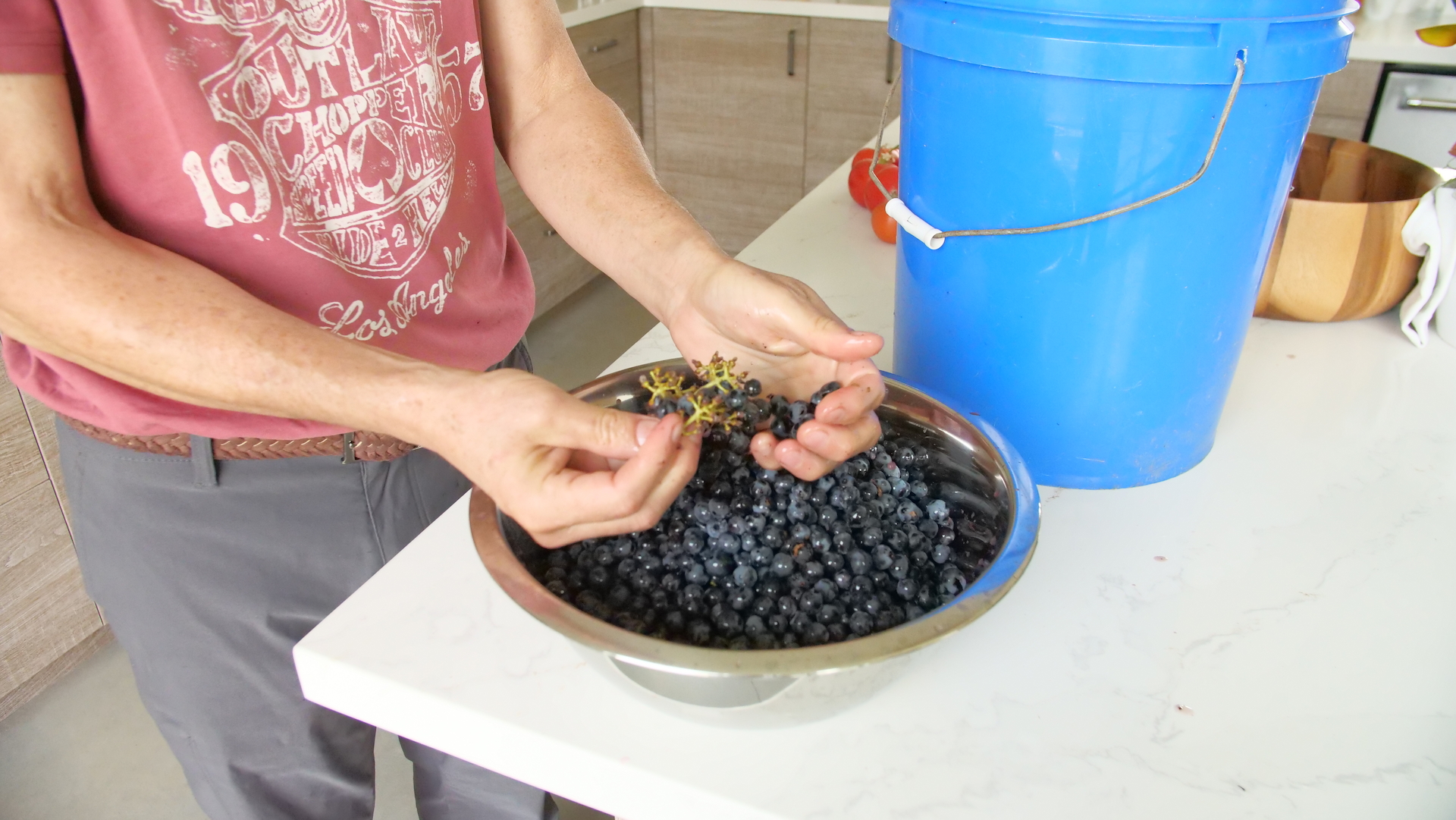
In this video I explain the process for testing to see if the grapes have been affected by the smoke from the recent fires. This entails doing micro-fermentation of grapes the three vineyards that I farm. Next week will send samples off to the lab, where they will test the wine for the presence Guaiacol. If there are more than 5 parts per billion the smoke will be present in the wine. The results will determine whether i harvest this year's crop or drop it on the ground to provide more nutrients for the vines.
Dodged A Bullet
September 9th, 2019
Although I was prepared I am grateful that I did not have to test my defenses. On Tuesday afternoon I thought the fire would overtake me that night, but a lucky change in wind direction blew it to the east.
From Wildfire To Pandemic, How One Napa Winemaker Keeps Going
September 4th, 2020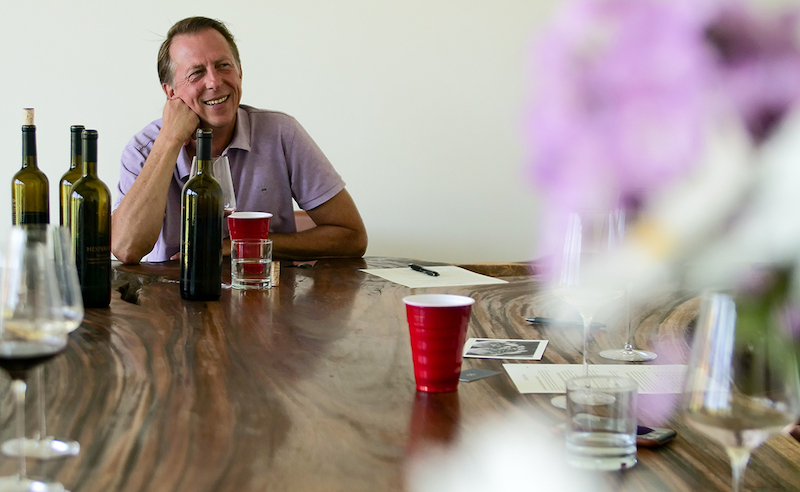
Philippe Langner, owner and winemaker of Hesperian Wines, started his winemaking career in Bordeaux, but his life experiences have taken him across the globe from El Salvador to Zaire. Now, he can add pandemic and wildfires to his experience file. Indeed, just these past few weeks Langner, who lost nearly everything three years ago in the Atlas Peak fire, has been preparing for yet another wave of wildfires. “I can't believe that I once again face the threat of fire,” says Langner. But, he is a master of detail and patience, and this time he is ready, “When I rebuilt I only used concrete, steel, and glass. In addition, I installed a 4-inch water line around the perimeter and equipped it with vineyard sprinklers capable of soaking everything within a 27 ft radius. Hopefully this time my loss will be minimal.”
That same forward-thinking applies to his winemaking. Unlike many other winemakers, he insists on letting his wines hold in the bottle one to two years longer to be sure that upon release the tannins have softened just enough. That patience has been nicely rewarded with critical praise and a passionate consumer fan base. He recently shared his take on the Pandemic, surviving the Atlas Peak fires and why he works harder in the vineyard than in the cellar.
While working at Sullivan Vineyards, I discovered a small vineyard that produced exquisite fruit. It had this depth, with an earthiness at same time and the vineyard was a growers vineyard, planted on slope, in poor volcanic soils; it had everything to produce really good grapes. So I checked the bank account and bought the plot, and from that beginning Hesperian evolved.
Who are your wine mentors? I would not say I have any, I don’t do well with authority, and I learn from mistakes.
What do you want people to feel when they drink your wine? I want them to have a nice aesthetic experience but also a thoughtful one, I think my wines are nice and tasty, but they are a bit intellectual in a way.
I do like plant character in wine. I like herbaceousness, not tomato leaf or bell pepper, but a plant edge with mintiness. My vineyard up there allows me to pursue that. It has some steep slopes, all sorts of aspects and varying exposures. There are some rows I will pick three times—I have a month’s difference between the top and bottom for picking. We pick little sections here and there as they are ripe, so it’s labor intensive and consuming, but that’s what you do.
How did the 2017 Atlas Peak Fire affect you? Thankfully my winery was not built at the time of that fire, we were custom crushing, but I did lose the house, equipment, and some of the irrigation system. The edges of the vineyard got burnt, but not the vineyard—I lucked out, that was the saving grace.
COVID-19 has impacted me in some ways. In a way, we can work in vineyard and be safe, but from the business standpoint I was extremely worried. I hosted a big sale of older vintages and got nice results from that, but you can only bother your mailing list so much. I am happy now as I recently received an order from my distributor for Anatomy to be sold in Costco.
I work harder in the vineyard than in the cellar. The fruit in these vineyards is extremely tannic and I have had to re-learn winemaking to soften the edges. The tannins are strong because the fruit struggles. It’s amazing –sometimes you wonder how they grow because it’s a pile of rocks, but these vines are living on the edge. You have to suffer a bit to be interesting.
2015 is my current release. I wait longer than other wineries (most Napa current releases are 2016 or 2017) because I need to wait for the wines to start showing finesse, and that’s the price I have to pay. Fruit bombs are good for cash flow, but I love complexity in wine and the transformation in the cellar is really fascinating.
I make Anatomy to reach people who want a nice Napa wine but can’t afford the high prices. People should be able to have good wine at decent price, I used to work to sell Anatomy, and now buyers come to me.
Current Releases:
Hesperian Napa Valley Cabernet Sauvignon, 2015: The current release on this sultry, deeply nuanced Cabernet is 2015—which means it waited five years before making its debut. It shows densely woven red-black fruit over a bit of spice and earth. I love this wine as much for what it is and what it is not—it is not cloying, over-ripe or extracted. It is dynamic, layered and rich but with a balanced core. $100
Hesperian Kitoko Vineyard, Cabernet Sauvignon, Atlas Peak, 2015: This is the Hesperian flagship bottling. Like the Napa Valley Cabernet, this release also waited five years before release. Abundant with black cherry, spice and mint, it shows the polish, succulent texture and finesse of a world-class wine.
Anatomy Napa Valley Cabernet Sauvignon, 2015: This affordable wine is a blend of vineyards, with a juicy plum nose and layers of cherry, eucalyptus and cassis on the palate. Bold and structured but ready to drink now.
This Time I am Prepared
August 18th, 2020
Getting ready for another impending fire. Just three years after losing nearly everything, I can't believe that I once again facing the threat of fire. Realizing climate change is greatly increasing the odds of facing more frequent fires are high so when rebuilding I only used concrete, steel, and glass. In addition, I installed a 4-inch water line around the perimeter and equipped it with vineyard sprinklers capable of soaking everything within a 27 ft radius. Hopefully this time my loss will be minimal.
Big Crop for 2020
August 15th, 2020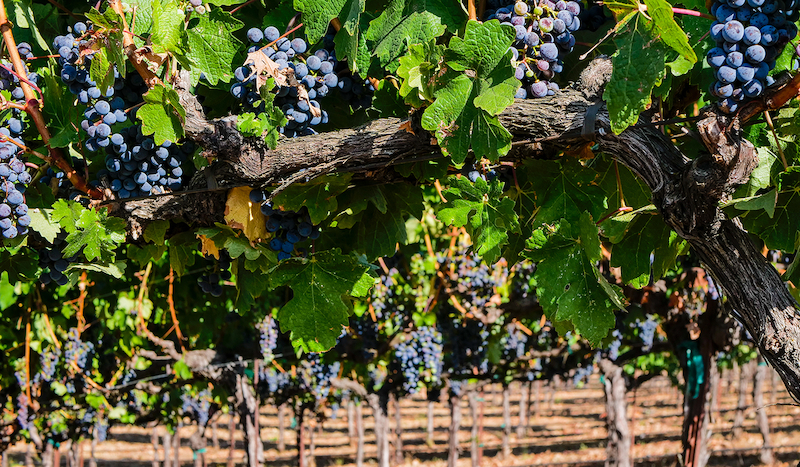
2020 is looking like an exceptional crop. The number of clusters per cane, the number of berries per cluster, and the size of the berries are the key factors to contribute to how big the crop is. Weather, disease, flowering, pollination, fruit set, as well as, how we manage the vineyard affect those three factors. This year we started with most canes having two or more clusters. That is what we like to see, but it is seldom the case. Like most perennial plants, grape vines have a two year reproduction cycle, buds initiated during shoot growth this spring slowly develop over the summer to produce buds with predetermined clusters for next season. The weather in the spring of 2019 was responsible for the high cluster count we have now. The abundance of clusters, early bud break and ideal weather so far is setting up the 2020 vintage to be a big, intensely flavored crop. But, as farmers often say” don’t count your chicken before they hatch'. We still have 6 weeks before harvest and many things can happen.
Veraison at Kitoko Vineyard
August 2nd, 2020
Veraison is the term used for when the grapes turn from green to dark blue. When it happens is determined by when buds form and the weather that transpires afterward. Cool breezes on Atlas Peak cause bud break to occur later than most of Napa Valley, also delaying color change. Grapes are ready to harvest approximately 65 days after mid-veraison. This year color change is two weeks earlier than last year. I like this because it means there is a good chance we will be able to harvest in September. Since I have been on Atlas Peak, I have found that getting the fruit ripe early, not only reduces risk from fire and other hazards, it typically produces some of the best complexity and flavors for my style of winemaking.
Open For Tours
July 23rd, 2020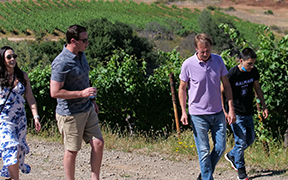
I feel fortunate to be located on Atlas Peak, where the air is clean, the breezes steady and open space is reminiscent of the wild west. Here I can feel safe in sharing my love for Kitoko Vineyard and my Hesperian wines. Those who have a chance to visit are treated to a walk through the vineyard and conversation under the old oak tree next to the lake.
The Table: Only thing that survived the fire
July 9th, 2020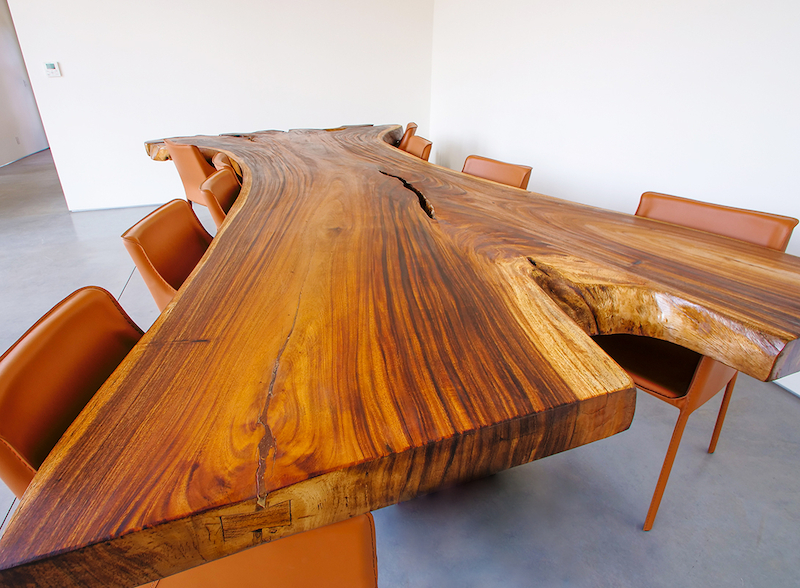
Several years ago, on a trip to Bali, I came across a huge giant slab from a tropical tree. When I got it home, I realized it was too big to fit in my old house, so set it up in the cabana by the pool. When the 2017 fire came through, the cabana was the only thing that did not burn, and my beautiful table survived. Now that my new house is complete, I had it refurbished. It is now in the great room.
Morning Fog
July 2nd, 2020
Now that I have moved back to my new house, I am so enjoying the quietude and picturesque views of Kitoko Vineyard. Some mornings cloud drift over the lake, creating an enchanting ambiance.
Vineyard workers social distancing in the Vineyard
June 16th, 2020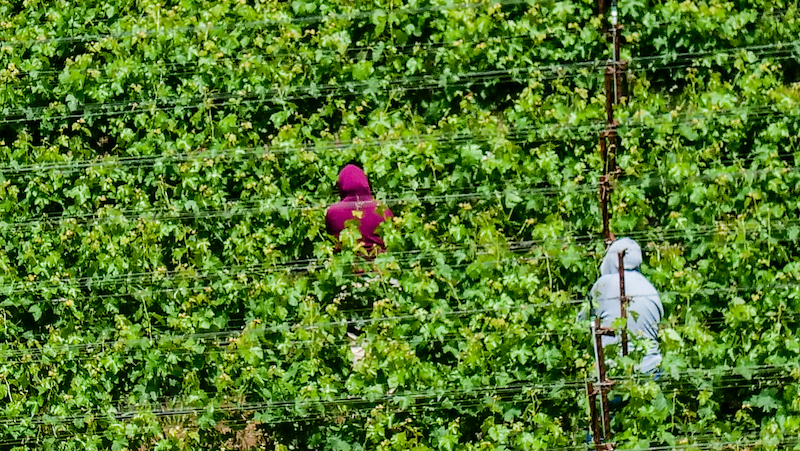
Most years, I hire a crew of 8-10 vineyard workers to help me with suckering ( the removal of excessive new growth). In a couple of days, they can complete the task. This year I took a different approach and hired two women to undertake the job methodically. It took them a couple of weeks, but they did great were able to work at least 10 feet and one row apart.
Tractor Time
June 8th, 2020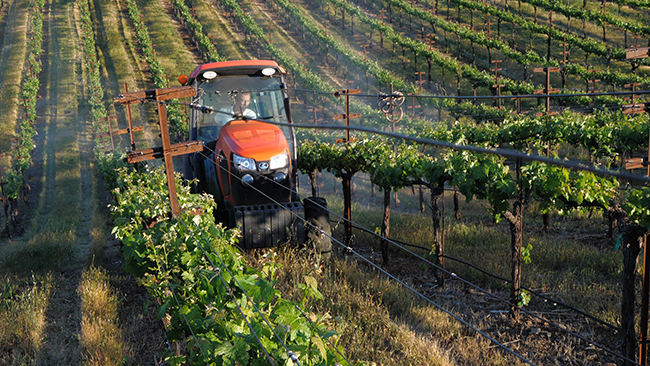
I find myself busier than ever this year. The COVID-19 restriction has further reduced the vineyard labor pool. Thankfully I can do much of spraying mowing and de-leafing myself on my tractor. Yes, I do enjoy it, but I am always happy when it is done.
New House and Renewed Inspiration
May 16th, 2020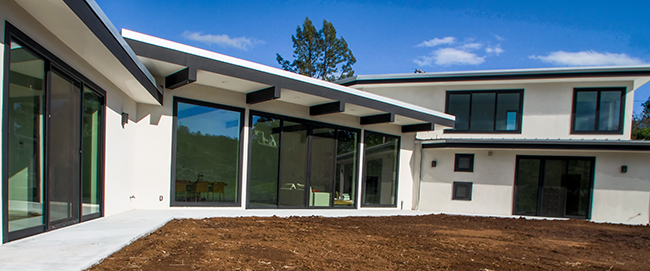
I has been a long road of recovery since the 2017 Fire, but finally I am back up on the hill and in my new house. Landscaping is in progressing and will be completes soon, then it on to restoring my gardens. The big space is taking some settling in but being back in the middle of my vineyard surrounded by vines is so soothing. Big open walls are begging for art. For several years, the urge to paint has been growing, now with the space and renewed inspiration who know what will come out.
Bud Development Time Lapse
April 15th, 2020
Kitoko Vineyard’s Cabernet vines enjoyed late winter rains and the warmth that April sunny days are bringing. While a month behind the Valley floor they are still a couple weeks ahead of last year. Buds are giving way to leaves as the vineyard spring to life and another season is on us.
Opening My Private Cellar
March 24th, 2020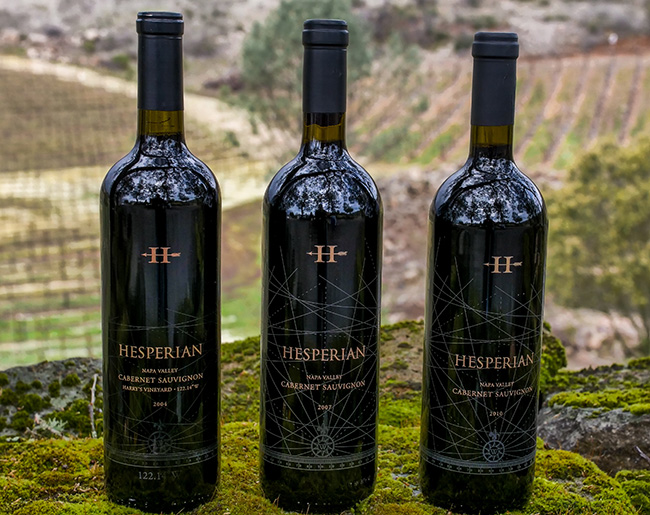
Up until now, I have been trying to follow the typical California convention in my business model, releasing wines at three years, knowing that there will be some time before they truly shine. COVID-19 and the shutdown provided a chance to reflect. I looked at all the great wine sitting my cellar, realizing many vintages were coming into prime drinkability. I decided it was time for them to be enjoyed. Club and allocation list members had the first chance and the best prices, then several fortuitous mentions in regional and national press brought in more orders.
Receiving an overwhelmingly positive response to opening my cellar was reassuring. I knew the wine was classic and collectible, but it felt good to see everyone appreciating it, not to mention finally see a return on my time and investment. I look forward to offering more great wine on select vintages.
Bud Break 2020
March 22nd, 2020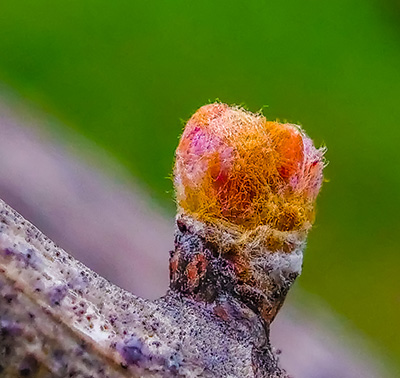
A warm, dry February brought an early bud break to south Napa Valley. At Kitoko Vineyard on Atlas Peak, things happen later, but we too are seeing buds form about one week earlier than last year. Early buds often equate to an early harvest and reduced risk of fire, rain, and other new considerations that are part of the new normal in Napa Valley.
Covid 19 Response
March 18th, 2020
In this time of uncertainty, I encourage everyone to stay positive to protect yourself and be a responsible member of your community. To that end, we will not be hosting tours or events until local authorities give us the all-clear. To help survive the disruption to business, I am opening my cellar of library wines. This is an excellent chance to acquire a selection of fine wine wines aged to perfection at drastically reduced prices.
Lot #14, Premier Napa Valley
February 22nd, 2020
Premier Napa Valley 2020 raised $3.9 million to help promote, protect, and enhance the Napa Valley. This the third year that Philippe has donated an auction lot. The $8000 bid by John York's owner of SF 49ers was the winner of the Hesperian 5 case auction lot #14.
PNV Atlas Peak tasting
February 20th, 2020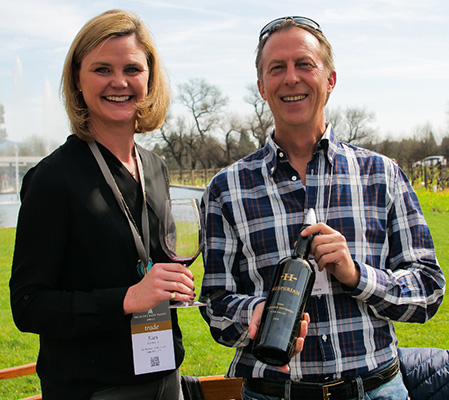
The Atlas Peak AVA pre-auction tasting provided wholesale wine buyers and collectors and opportunity to taste the wines with fruit sourced from Atlas Peak. Philippe had a chance to sample Kari Karwoski, Wine club manager for the SF 49ers who then went on to be top bidders of the Hesperian 60 Bottle auction lot.
Hesperian wine follows its own star
December 26th, 2019
“Hesperian is not a place, it’s an idea,” Langner said. “It’s about crafting something beautiful, complex and individual. Over time my ideas about winemaking have changed. Whereas I once looked to power and intensity, I now look for sensitivity, precision and delicacy as a way to best express our vineyards’ particular personalities.”
Many believe that the first “Judgment of Paris” was a wine event held in 1976 that put Napa Valley wines on the world stage. But that’s not the case. The phrase was first used thousands of years ago.
In ancient Greek mythology, the Hesperides were nymphs who tended queen-god Hera’s westernmost garden. A tree grew within the garden that produced golden apples, one of which the goddess of discord, Eris, gave as a wedding gift. The result was the original Judgement of Paris, which set in motion what eventually became the 10-year Trojan War that Homer chronicled in “The Iliad” around 750 B.C.E.
Since then, the word Hesperian has morphed to mean anyone living in the West, but it can also refer to the western evening “star,” Venus. But for Philippe Langner, owner of Napa Valley’s Hesperian winery and vineyards, the word means something more.
“Hesperian is not a place, it’s an idea,” Langner said. “It’s about crafting something beautiful, complex and individual. Over time my ideas about winemaking have changed. Whereas I once looked to power and intensity, I now look for sensitivity, precision and delicacy as a way to best express our vineyards’ particular personalities.”
Philippe Langner — a world traveler
To say that Langner is well-traveled is an understatement. He was born in El Salvador, grew up on family ranches in Zaire (cattle, pisciculture and citrus) and Colombia (cattle) and moved to Switzerland when he was 16 to finish school. Next, he headed to the United States, where he attended UC Davis, graduating with a double master’s in agronomy and agricultural economics. As a result of his nomadic life and the heritage of his German father and Parisian mother, Langner now speaks French, Italian, Spanish and German in addition to English and at least a little Congolese-Lingala, a language spoken in Zaire.
After school, Langner moved to France, where he worked for La Compagnie Financière Edmond de Rothschild Banque in Paris. But he found city life constraining and longed to feel the earth beneath his feet again. On a recommendation from his sister, Ariane — who is married to Benjamin Rothschild, a son of Baron Edmond Rothschild — Langner headed to Bordeaux to spend a “short time” working at Château Clarke in Listrac-Médoc. The chateau has been owned by a part of the Rothschild banking family since 1973.
Once there, Langner felt at home, and he extended his stay for five years as he learned the life of a vigneron and winemaker, training under luminaries such as Jacques Boissenot and Michel Rolland before heading to South Africa and the Fredericksburg Winery (Rupert & Rothschild Vignerons) winery for a year.
In 2001, Langner spent a vacation in the Napa Valley. There, he thought he’d visit wineries, take in the sights, and indulge in good food and wine. Never did he guess that he would become so smitten that he’d make it his permanent home.
“I’ve been to some wonderful places on this earth,” he said, “but there’s just something about the Napa Valley.”
After a friend introduced him to the Sullivan family in Rutherford they hired him in 2002 and he eventually became their viticulturist and winemaker. By 2010, he had started his own brand and taken on other clients as their winemaking consultant. He purchased a home and a 14-acre vineyard in the rocky eastern hills above the city of Napa in an area called Atlas Peak.
‘Kitoko’ means beautiful
Although Langner obtains grapes from a variety of different vineyards throughout the region, he has a particular love for his Atlas Peak vineyard.
“I named this vineyard Kitoko, which is the Congolese-Lingala word for ‘beautiful,’” he said. “The name is apropos because the wine that comes from the Kitoko vineyard is perfumed and complex yet more nuanced and subtle than you might expect from grapevines growing in such rugged conditions. It’s basically a pile of rocks up here, which forces the vines to struggle, only producing limited amounts of concentrated fruit per vine.”
During a tour of his vineyard ranch, he talked about his winemaking approach and his plans for the future. He said then that he had lost his home in the 2017 fires. Up until that point, his laughter had been loud and often, but as we approached where his home had once stood he became quiet and hesitant. In front of us a lattice of shiny metal beams formed the skeleton of what would become his new house, its silvery bones glinting in the sun.
He’d lost his home, the barns and the tool sheds, and the fire was so hot and fierce that even a few acres of vineyard had succumbed to the relentless heat.
“I lost nearly everything,” he said, his voice tight. “Fortunately I make the wines off-site at a facility in the valley, so the wines were OK, but other than that…”
He waved his arms to indicate that the flames had consumed almost everything else.
“I even lost my winemaking notes that I had kept on every wine I’d ever tasted — poof, gone,” he said. “I’m rebuilding in such a way that that will never happen again.”
Langner is building with metal and plenty of fire protection — a 2-inch water pipe around the entire house that can soak it when needed. He is also building his winery within caves for both protection and energy conservation.
But rebuilding has taken much longer than he’d imagined and has cost at least twice as much as he expected.
“I feel compelled to rebuild, but it’s not easy,” he said. “It’s not only the time and money, but when the winds came up again this year during harvest I was honestly surprised by my reaction — I felt panicked. It felt as if I needed to harvest the grapes before a fire destroys them again.”
Luckily, there were no fires in Atlas Peak in 2019, but the memory of the terror in 2017 lingers. This might be especially true for residents of Atlas Peak, where six residents perished, hundreds of structures were burned to the ground, thousands of acres lay scorched, and nine wineries were damaged or destroyed. And yet, even with the trauma and devastation, the small community is slowly returning, with vintners such as Langner determined to push forward, believing that Atlas Peak and its nearby neighbors on Prichard Hill produce some of the finest wines of the region.
The wines of Philippe Langner
Langner has made many different types of wines during his career, but now he focuses his attention on making Cabernet Sauvignons, including the 2015 Hesperian Kitoko Vineyard ($150 a bottle with only 300 cases made), the 2015 Hesperian Napa Valley ($100 a bottle with 300 cases made) and the 2014 Anatomy blend ($45 a bottle and 3,500 cases made). Because of his belief that wines should be aged longer than what is customary, the wines are often released a few years after their peers.
The Kitoko is opaque with a brick-red rim. Aromatics of red-cherry liqueur, herb-roasted mushrooms, Morbier cheese, Chinese five spice and mulled wine coupled with silken-but-ever-present tannins reminded me of Lynch Bages with its wonderful acidity and balance that produces an elegant structure and a lingering, memorable finish.
The Hesperian Napa Valley is sourced from grapes grown in vineyards on the valley’s floor and has a distinctly different mouthfeel — plush and uncoiled — and yet it strangely has many of the similar aromatic nuances as the Kitoko in a sort of herb-roasted-meat quality. But these aromatics are not merged with a red-fruit core as in the Kitoko, instead this wine leans toward the darker side with licorice, sun-warm plum, dark-roasted coffee and a wonderful creamy cinnamon-toast finish.
Anatomy is a simpler, but still lovely, wine that would make any fan of Beringer Knights Valley Reserve Cabernet Sauvignon sit up and take notice. Aromas of fig, clove and lavender join flavors of black cherry and huckleberries with a finish of black olive, wild sage and mocha chocolate. This is a more consumer-friendly version of Langner’s wine perhaps, but it retains the elegance found in the more expensive alternatives.
To taste the wines, we’d come to a wooden picnic table on the bank of a pond that was surrounded by vineyards that sloped skyward. The only sounds were our voices, the occasional cry of a hawk and the light breeze that rustled through the reeds that lined the shore.
“This place is worth the effort,” he said. “There is so much more to learn, so much to do.”
He then paused and grew silent and serious as he slowly put both hands on the table as if bracing himself. He then leaned his head back and looked up at the sky. It wasn’t clear if he was looking for divine guidance or checking the sky for smoke before lowering his gaze.
“We have a lot of work ahead of us, but this is important,” he said and then let out a long breath, shaking his head slightly.
Until the winery is ready for visitors (sometime in 2022-23) anyone who is interested can book a tasting of Hesperian wines at the Kitchen Collective located at 1650 Soscol Ave., or find the wine at Backroom Wines in Napa and V Wine Cellars in Yountville. For more information or to purchase wine, visit www.hesperianwines.com.
Striving for Perfection on Atlas Peak Cabernet
December 17th, 2019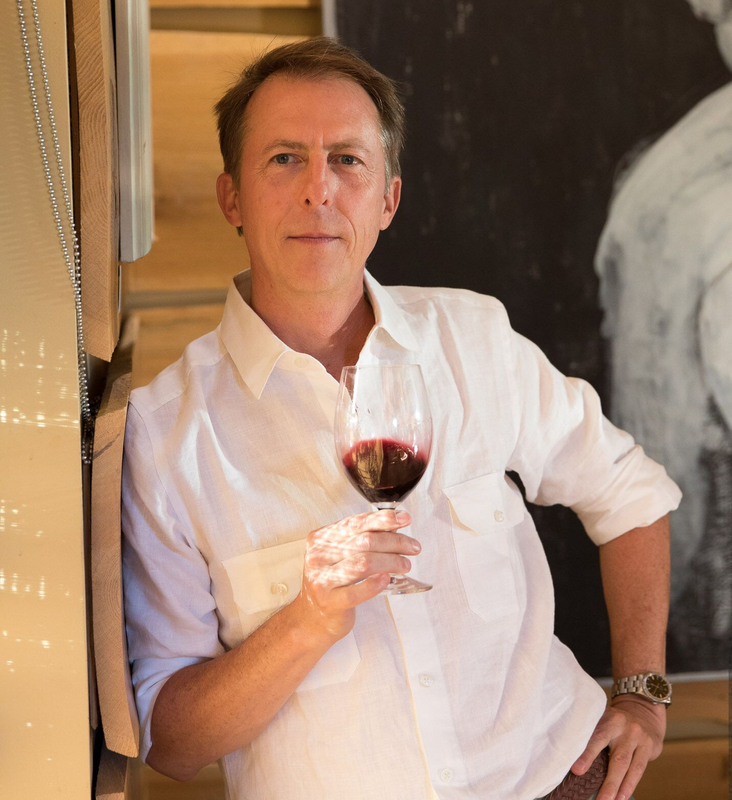
Napa Valley Life Magazine BY DANIEL MANGIN
Rather than make a splashy entrance, Langner’s soulful yet structured wines cast a slow, subtle, profoundly satisfying spell.
Halfway up Atlas Peak, surrounded by scrub oaks, chaparral, and manzanitas, Philippe Langner of Hesperian Wines meticulously farms, mostly by hand, his hilly, rock-bestrewn Kitoko Vineyard. Hesperian’s owner, winemaker, and viticulturist, the cosmopolitan Langner reserves the majority of its grapes for his flagship 100% Cabernet Sauvignon. Named for the 14-acre vineyard, elevation 1,350–1,450 feet, the collector-worthy wine is, like its creator, lyrical, intellectual, passionate, refined, and resolute. Born in El Salvador to a German father and French mother, Langner was raised mostly in Zaire, now the Democratic Republic of the Congo. (Kitoko means “beautiful” in Lingala, a Bantu language spoken there.) Plants fascinated the future winemaker from an early age—so much that he pursued dual master’s degrees in agronomy and agricultural economics at UC Davis. Upon graduating, though, he took a job—as a banker.
“It was terrible!” Langner recalled recently with a laugh. “I did M&As (mergers and acquisitions) for six months, and that was it.” Luckily for him, the bank-owned a Bordeaux winery. One of his bosses suggested Langner explore the wine business, and to his surprise, “I fell in love with all aspects of winemaking,” he said. “Particularly the many adjustments that occur in the vineyard to achieve the best possible fruit.” Langner credits his four-year stint in France and subsequent nearly decade-long run at Sullivan Vineyards in Rutherford with helping him appreciate how vineyard and cellar decisions reverberate throughout a wine’s life. The challenges of Atlas Peak, whose craggy terrain begets vigorous tannins, required him to devise regimens to create wines suitable for aging yet supple enough to drink young. In addition to the Kitoko Cabernet, Langner produces a 100% Cabernet blend of grapes from Kitoko and a Coombsville vineyard.
Private tastings, most conducted by the genial winemaker himself, begin with a drive to Kitoko, whose southernmost blocks afford San Francisco views on a clear day. The vineyard excursion complete, Langner escorts guests to the Kitchen Collective, a private restaurant in downtown Napa, where he pours the two current Cabernets and an older vintage that illustrates how gracefully the wines age. Another way to sample Langner’s output is by attending the winemaker’s salon at the Kitchen Collective on the third Saturday of the month. “I bring wines of varying ages, and we taste them one by one with the wonderful food made here,” said Langner. “Sometimes we have a special guest speaking on a specific topic, but often the conversation about wine just goes where it goes.” Many people who collect wine describe it as a personal journey reflecting their evolving palate, interests, and knowledge. Those who follow Langner’s career accompany the winemaker on a similar voyage as he strives to achieve his goal of “a perfect, honest expression of Kitoko”—and by extension, Atlas Peak—in the bottle.
Napa Valley Mountain Cabernets: Head to the mountains for outstanding flavor
November 25th, 2019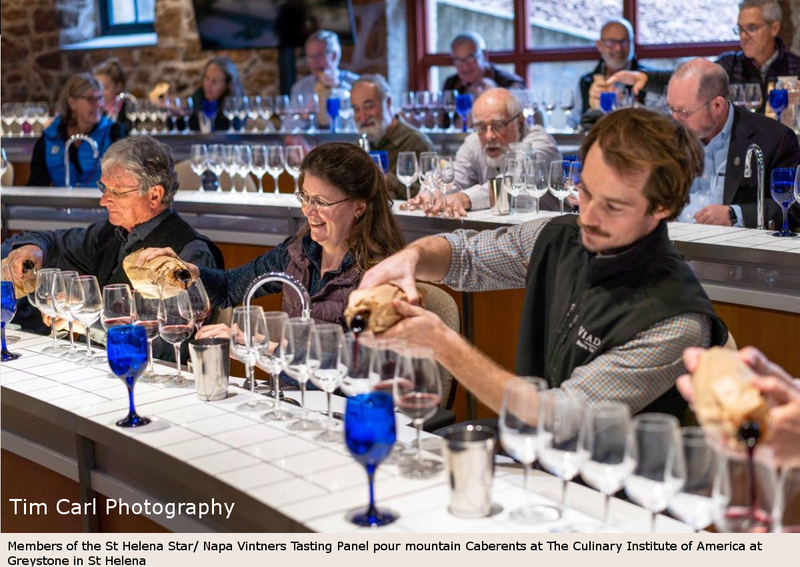
"Farming is in winemaker Philippe Langner’s blood, and this wine shows the expert hand of deep, dark fruits made fresh with bright acidity." by CATHERINE BUGUE St Helena Star
There is something about the hills that speaks to many a soul. Whether it’s a recollection of childhood “King of the Hill” triumph or enjoying the powerful sensations of height and distant views, it draws us to hike, climb, camp and just be at elevation.
Mountain AVA wines were the topic of November’s St. Helena Star/Napa Valley Vintners Tasting Panel session, and you could feel the anticipation of the group at the Culinary Institute of America at Greystone. The amphitheater-style classroom was packed with 28 panelists and the volume of discussion throughout the afternoon was high.
Six flights of wines, totaling 30 samples, were tasted from the 2015 and 2016 vintages. Divided by AVA, the flights went geographically, starting south and moving northward: Mount Veeder, Atlas Peak, Spring Mountain, Howell Mountain (two flights), and Diamond Mountain.
Reflecting on V2019
October 4th, 2019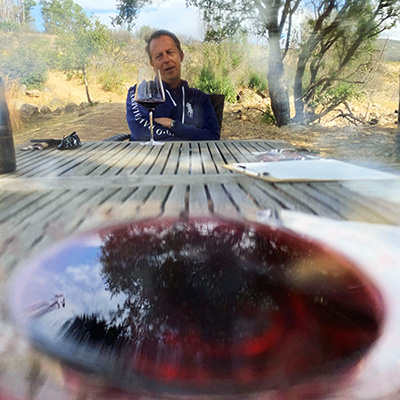
2019 has had its challenges and near misses. A long wet spring brought late bud break and fruit development. High winds and heat waves during flowering brought fears of a repeat of the 2015 shatter from hell. Then October unprecedented winds, fire threat and power outages had me reliving the nightmares of the 2017 fires. I am feeling very relieved now that all the grapes are in tanks. All in all, it looks like an excellent vintage, in fact it is the first time I have harvested grapes with brown nutty flavored seeds off of the Kitoko vineyard.
Vintage 2019 First Pick
October 13th, 2019
First pick from Kitoko Vineyard looks very good. Last weeks wind stripped the vines of dead leaves making picking clean and easy. With no rain in the forecast we anticipate harvesting small blocks at optimal ripeness until it is all in.
The Wine Women Radio Podcast with Marcia Macomber
October 2nd, 2019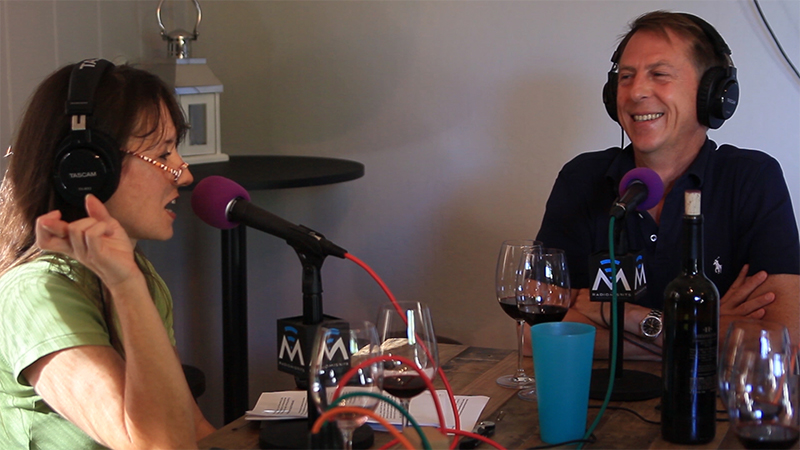
Wine Women Interview with Philippe Langner
"I didn't want to put my name on the bottle because there's too much ego involved, and I'm trying to reduce it."-- Philippe Langner
EP17: Philippe Langner decided to start his own wine brand in the true West despite his peripatetic life in Central America, South Asia, South America, Africa, and Europe. In homage to the Garden of the Hesperides, Hesperian’s vineyard, at 1,400-foot elevation overlooking the valley from atop Napa’s Atlas Peak, Langner’s Hesperian — “One of the West” – was founded in 2004. A true vigneron, Philippe holds two masters degrees from U.C. Davis and oversees all aspects of farming his mountain vineyard. He joins host Marcia Macomber on the show at Napa’s Kitchen Collective, where monthly salons are held with fans of HesperianWines.com. Tune in as they taste through Philippe’s Cabernet Sauvignons and discuss his career and life trajectory to Napa Valley, as well as his life-long love of all things that grow. He insists, “I work harder in the vineyard so that my winemaking can be as simple as possible.”
PalateXposure Podcast with Illona Thompson
September 29th, 2019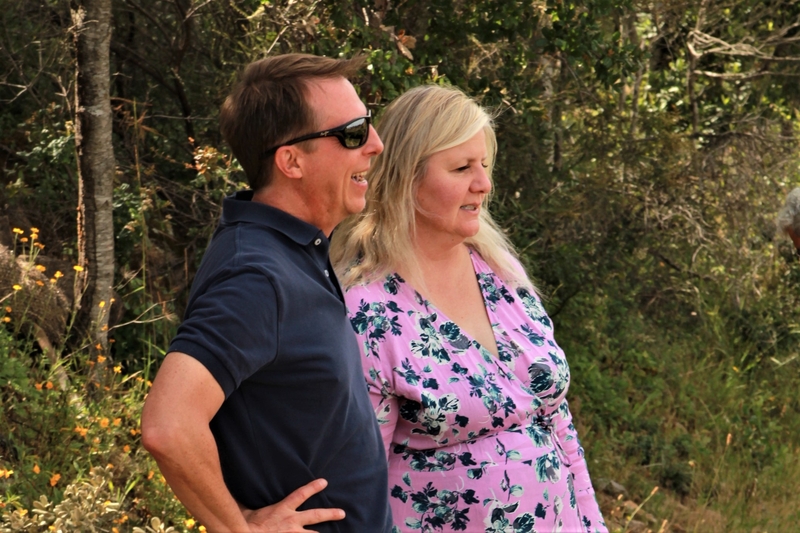
"You learn to sense, and taste and look for what you're trying to achieve. -- Philippe Langner
In this episode we sat down with Philippe Langner to learn more about his story, his vineyards, and Hesperian Wines! You’ll enjoy hearing his story that crosses several countries and continents.
Session One: Zaire to banking then wine
"I stuck to Cab because Cab is king in Napa but also because I felt I needed to create an identity ..."
September 6th, 2019
Weekly Wine Show podcast By Tony and Betty Notto .
This week features our interview with viticulturist and winemaker Philippe Langner of Hesperian Wines our of Napa Valley. Click Here to Listen
Discovered by Player FM and our community — copyright is owned by the publisher, not Player FM, and audio is streamed directly from their servers. Hit the Subscribe button to track updates in Player FM, or paste the feed URL into other podcast apps.
Danny Mangin is at Hesperian Wines.
September 26th, 2019
Langner makes a complex, soulful 100% Cabernet from Kitoko fruit (pic 3) and a Napa Valley Cabernet that’s a blend of Kitoko and Coombsville grapes. Only 300 cases of each in 2015. More about the wry and dry-as-his-wines Langner and our tasting at Kitchen Collective with Greg Sweval in a mag profile appearing later this fall.
You can taste Hesperian Cabs this weekend — along with wines from a dozen other Atlas Peak Appellation Association wineries — at the AVA’s annual A Taste of Atlas Peak celebration (Sept. 28th, Black Stallion Estate Winery). Good group, including Acumen Wine, Antica Napa Valley, Duckhorn Vineyards, Michael Mondavi Family Estate, and Prime Solum Tasting Barn. Tix/info here: bit.ly/_taste_of_atlas_peak_2019
What’s the Deal with “Mountain” Cabernet?
September 16th, 2019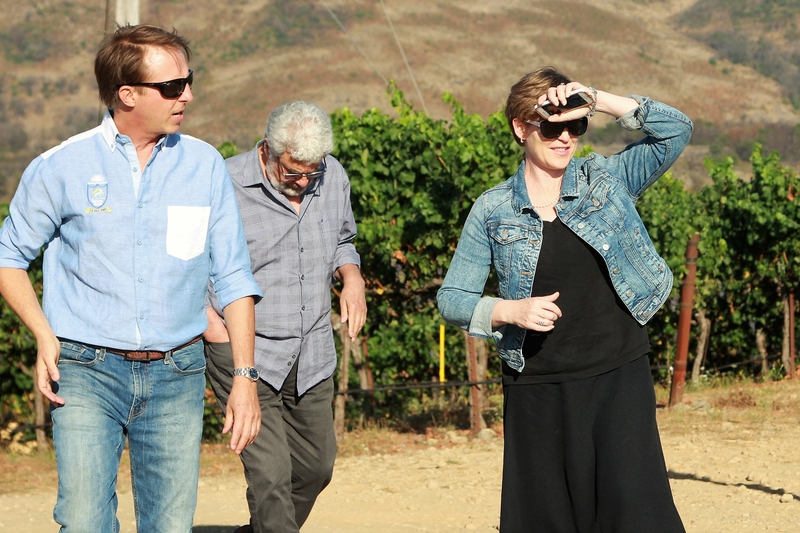
Paste Magazine Excerpt By Amy Glynn September 16, 2019
"The wine made from these vines is-well, I might as well commit to this astrology trope, because Hesperian’s Kitoko Vineyard Cabernet is pure Sagittarius. Urbane and worldly, sanguine and philosophical, a wine with an unhurried, understated-elegant kind of vibe and a genial, sociable nature. ... There’s a great depth and purity to it, precise focus, lovely dynamic tension, a certain wide-ranging-ness that somehow suggests intelligence."
Meanwhile, on Atlas Peak, Philippe Langner’s new, more fireproof house is under construction, and Cabernet vines roll gently over the edge of a pretty intimidating slope-walking in the Kitoko vineyard can give you pause (and vertigo). The vista’s gorgeous even with the still very noticeable burn scars that crisscross Napa Valley. The wine made from these vines is-well, I might as well commit to this astrology trope, because Hesperian’s Kitoko Vineyard Cabernet is pure Sagittarius. Urbane and worldly, sanguine and philosophical, a wine with an unhurried, understated-elegant kind of vibe and a genial, sociable nature. The 2015 Cab is a beautiful wine from a less-than-beautiful vintage (Philippe has been brutalized by Mother Nature more than once), and more nuanced than a lot of Napa cabs, at least for my money. The sheer amount of layering in this stuff rivals a good pinot noir: an olfactory tapestry of cherries and blackberries, leather and coffee, cedarwood and incense, blackcurrant and toasted bread, spearmint and violets, cocoa powder and oak and a trace of what might be the absolute sexiest smell in the world to a writer: old books. There’s a great depth and purity to it, precise focus, lovely dynamic tension, a certain wide-ranging-ness that somehow suggests intelligence. You can pair it, as I was fortunate enough to do, with a dinner table crowded with wild mushrooms and witty, interesting, well-traveled people; it’s a cultivated beverage well-suited to cultivating relationships.
Somm In the City
September 9th, 2019
By Sara Lehman, September 9, 2019
"These wines are terroir-driven, which is what makes them more 'old-world' in style, but because of the long maceration periods and his winemaking techniques, the 'new world' fruit is very present in the wines as well. I had the opportunity to try the 2015 Napa Valley Cabernet Sauvignon, as well as the 2015 Kitoko Vineyard, Napa Valley Cabernet Sauvignon. Both wines are bold and powerful, but also elegant and complex with nice mineral notes and silky tannins."
Hesperian Winery owned and operated by Philippe Langner is a winery founded by a lifelong fascination with plants and nature. The first vintage was 2004, and Philippe has been producing limited production, high end, old-world style Cabernet Sauvignon in Napa Valley, California.
I had the pleasure of meeting Philippe for lunch at The Dutch in SOHO, NY. Here we enjoyed an afternoon filled with conversation, great food, and incredible Cabernet. Philippe is both a master viticulturist as well as a winemaker, with his own estate: Kitoko Vineyard. He grows only Cabernet Sauvignon, a staple grape in Napa that thrives and is loved by many. Now, because it takes at least seven years for new vines to start producing fruit use-able for winemaking, Philippe purchased fruit from vineyards that he trusted and could work with, in order to produce wines outside of Kitoko Vineyards, but still in Napa.
These wines are terroir-driven, which is what makes them more “old-world” in style, but because of the long maceration periods and his winemaking techniques, the “new world” fruit is very present in the wines as well. I had the opportunity to try the 2015 Napa Valley Cabernet Sauvignon, as well as the 2015 Kitoko Vineyard, Napa Valley Cabernet Sauvignon. Both wines are bold and powerful, but also elegant and complex with nice mineral notes and silky tannins.
Hesperian offers a wonderful membership, where you can enjoy these small productions, very sought after wines.
2015 Hesperian Napa Valley Cabernet- This wine is plummy with light toasty notes and some jam qualities. This wine can age well for another 10 years, however, if you wanted to drink it now, you certainly can. It’s a big wine full of character and nice juicy purple fruit, spending 20 months in 50% new French oak barrels. Only 300 cases of this wine are produced, which is why I love these wines to give as gifts as well as collect for some cellaring.
2015 Hesperian Kitoko Vineyards Napa Valley Cabernet– A wine from his single estate made from 10 tons of fruit from 14 acres. This wine is a bit more complex than the other 2015, and offers crushed blackberries, cigar spice, and dried herb notes and flavors. It also spends 20 months in oak, but with 80% new French oak barrels, giving it more spice and concentrated flavors.
I loved these wines after trying them at The Dutch, where they easily paired with everything from Buratta to Tuna, and of course, my bunless burger! Upon the first sip of the Kitoko Vineyards, I knew I had to showcase these wines with a rooftop event at One Sixty Madison. Since im the private Sommelier of the building, I knew the residents would love to try these wines, and because it’s coming into the fall season, these wines are ideal.
Philippe was recently in NYC again and we decided to host a Hesperian Pop Up at One
Sixty Madison. The wines were a huge hit, and to show just how well these wines can age, Philippe brought a very special vintage: 2007. The 2007 Napa Valley Cabernet Sauvignon was outstanding, with noticeable age that made this wine very alluring. On the nose, this wine expresses dried figs, black fruit, and spice. The palate is elegant and refined, with smooth tannins and a long lingering finish. Philippe said this wine can go another 8-10 years, but after 10 it may be tired. This is amazing to see at 12 years, how this wine was still fresh and fruit-forward, showcasing its longevity and appeal to the consumer. 2007 was a favorite among One Sixty Madison residents!
The wine club offers shipments of 3,6 and 12 bottles with free shipping with orders over $500, savings, and invitations to Hesperian club member events. If you’re seeking some special wines to gift to a collector, novice, or simply want to collect and cellar some incredible wines yourself than I absolutely recommend Hesperian!
93 Pts Hesperian Napa Cab
September 5th, 2019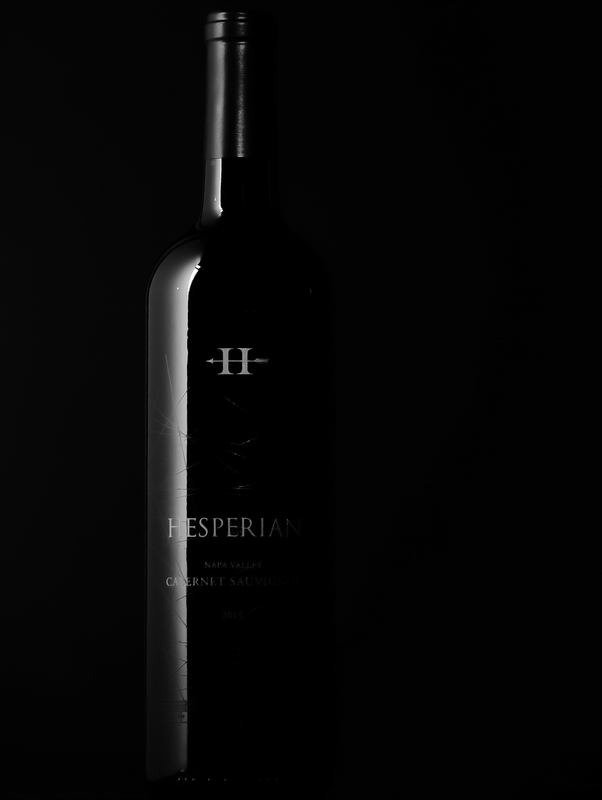
Posted Michael Franz Sep 3, 2019 Wine Review On Line
This very fine Napa Cabernet holds a broad appellation but is actually sourced in equal proportions from just two vineyard sites, Kitoko Vineyard (in Atlas Peak) and Upstream Vineyard (in Coombsville). It isn’t quite as concentrated as the 2015 Hesperian bottling sourced entirely from the Kitoko site, and there’s significantly less oak influence (30% new barrels, 40% once used, 30% twice used -- all French). However, this bottling’s balance is every bit as good, even though the wine isn’t as dramatic and won’t have as long a period of positive development. That may not make much difference to you if you’re intending near-term enjoyment, whereas saving $50 might seem more important. Frankly, you can’t go wrong with either of these. Both are very deftly crafted, and though they’ll probably be hard to find, they’re emphatically worth the effort.
Hesperian, Napa Valley Cabernet Sauvignon 2015 ($100):
93 Michael Franz Sep 3, 2019
96 Pts 2015 Kitoko Vineyard
September 5th, 2021
Posted by Michael Franz Sep 3, 2019 Wine Review On Line
I really don’t go out of my way to review small production wines (300 cases) in the $150 range from Napa, but this showed up on my tasting bench and I cracked into it without knowing how much it cost -- and it just kicked down the door. A very serious wine that is brought up in 80% new French oak (2nd fill barrels for the other 20%), this is already amazingly integrated. There’s plenty of toasty, spicy oak in the aromas and flavors, but they appear as accent notes, with rich, soft, very pure fruit easily holding center stage. This will improve for years, but not drinking it earlier will prove extremely difficult if you taste it now, so beware. The tannins are abundant but entirely appropriate to the weight of the fruit, and there’s no hint of over-ripeness or over-extraction. In short, this is very, very skillfully made, and much as I would prefer not to write this -- it seems worth every penny.
Hesperian, Atlas Peak, Napa Valley (California) Cabernet Sauvignon Kitoko Vineyard, 2015
93 Michael Franz Sep 3, 2019
Bigger Than Your Head
August 29th, 2019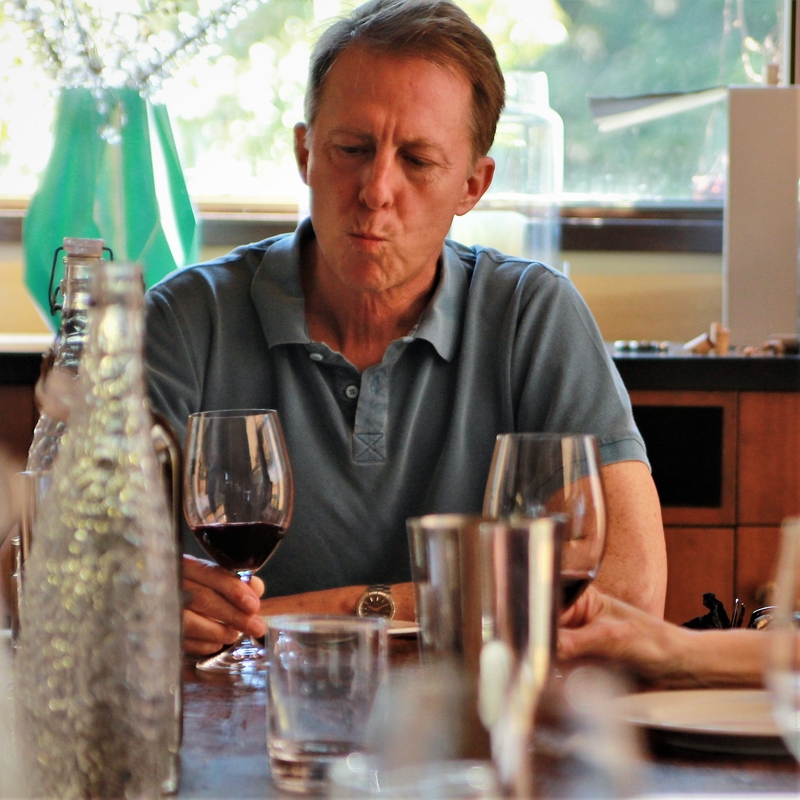
Posted by Fredric Koppel
[9] Comments
Lovers of old-fashioned Napa Valley cabernet sauvignon — that is, not over-ripe, not over-oaked, not over-alcoholic — should go online and order some of the Hesperian Wines Cabernet Sauvignon 2015. It’s not cheap, but it’s an exemplar of what mountainside cabernet is all about. One hundred percent varietal, the wine was made half from grapes grown in the winery’s 14.2-acre estate Kitoko Vineyard in Atlas Peak and half from the Upstream Vineyard in the Coombsville appellation; hence the Napa Valley designation rather than Atlas Peak. It aged 20 months in French oak, 50 percent new barrels. The color is an intense black-ruby hue that shades to a lighter purple rim; the wine offers the notes of heather, sage and wild thyme; lavender, brambles and underbrush we expect from hillside vines grown in rocky, dry, poor soil, stressing the vines and making them work hard, as well as concentrated touches of dusty currants and cherries; it’s a highly perfumed wine that displays an edge of graphite and slightly astringent spices like cloves and allspice; the wine is lithe and supple on the palate, framed by rollicking tannins and a steep grade of graphite minerality, yet for all its ribs and spine, its grip and traction, this cabernet is beautifully knit and elegantly balanced, even at this relatively young age; still, as the moments pass, it becomes increasingly dusty and granitic. 14.5 percent alcohol. Proprietor and winemaker Philippe Langner produced 300 cases. Try now with a medium rare ribeye steak, hot and crusty from the grill, or cellar it through 2028 to ’33. Excellent. About $100.
Life is a Cabernet! - Hesperian Wines Napa Valley
June 21st, 2019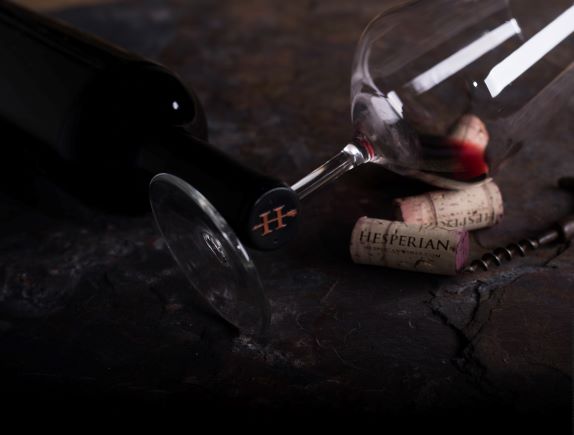
Posted on June 18, 2019 by Whine And Cheers For Wine
Two college friends on the phone being silly and excited about a new wine: “Life is a Cabernet old chum, life is a Cabernet“. So began the story behind this review. A play on song lyrics from days before our time. But we won’t go there. Celebration was in the air. Friends overdue for a wine-tasting and the news that Whine and Cheers for Wine had cracked the TOP 100 WINE BLOGS by Feedspot: Best 100 Wine Blogs, Websites And Newsletters To Follow in 2019.
The stage set; wine glasses, note pads, decanters, Coravin, glass identifiers etc. We were even ready for possible pairings; cheeses, charcuterie, nuts, and chocolates along with water crackers for palate cleansing. I say “possible” pairings because as I told the parties involved: “this is all about the wine”. We may pair, we may not. Eventually we did, but not before spending a long time getting to know the wines individually and comparative.
Hesperian Wines come with quite the pedigree thanks to winemaker Philippe Langner and his hands-on experiences from Bordeaux to South Africa and now California with a Rothschild influence here or there. From Hesperian Wines: California’s persistent call is an inspiration for the name for his domain. Hesperian, or “One of The West,” is a name that invokes the mythical garden of Hesperides, a blissful twilight orchard in the west where Hercules once tricked Atlas into helping him complete his eleventh labor. Today Philippe has chosen to make his home and his life’s work in one place: a steep, rocky, 14-acre vineyard named “Kitoko”, the Congolese Lingala word for “beautiful.” This is the place he has chosen to fulfill his vision, combining his exacting knowledge of viticulture and his constant quest for precision—indeed perfection—in winemaking. The Rest Of the Story
Early Fascination with Nature
June 19th, 2019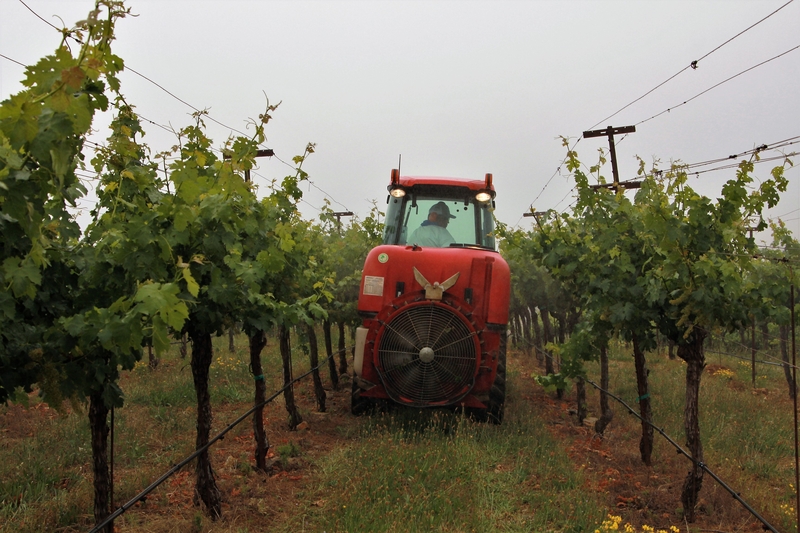
My fascination for the natural environment started at an early age. As a boy I loved the family adventures in the African bush and wrangling cattle on our remote ranch in Colombia. That love and marvel of nature evolved into respect and a sense of responsibility. The vineyard was farmed organically but after 3 years of mildew attacks I had to modify my farming and I started farming sustainably. What does this mean? I basically use a light mineral oil, classified organic, for my anti-fungal treatments. In June and July I add a systemic fungicide to the oil. Systemic fungicides get absorbed by leaves and circulated throughout the plant to protect all the part of the plant that can’t be reached directly by the spray. Systemics usually also protect the vines longer which has the added benefit of not doing too many tractor passes which compacts the soils (bad for plants) and uses more fuel to drive the tractor. I don’t usually like synthetic chemicals but you have to make a balance between fruit quality and a philosophical point of view. In the end it is about getting pristine fruit to make the best possible wine. A lot of people use sulfur to protect their vines but I absolutely detest the smell of sulphur, so don’t use it.
I now harvest when I feel the fruit is ready and not because the grapes are dehydrating rapidly due to the microscopic holes fungi make on the grapes’ skin. I now harvest pristine fruit and that cleanliness allows the fruit to shine more brightly in the wine.
Flowering, Pollination and Fruit Set
June 12th, 2019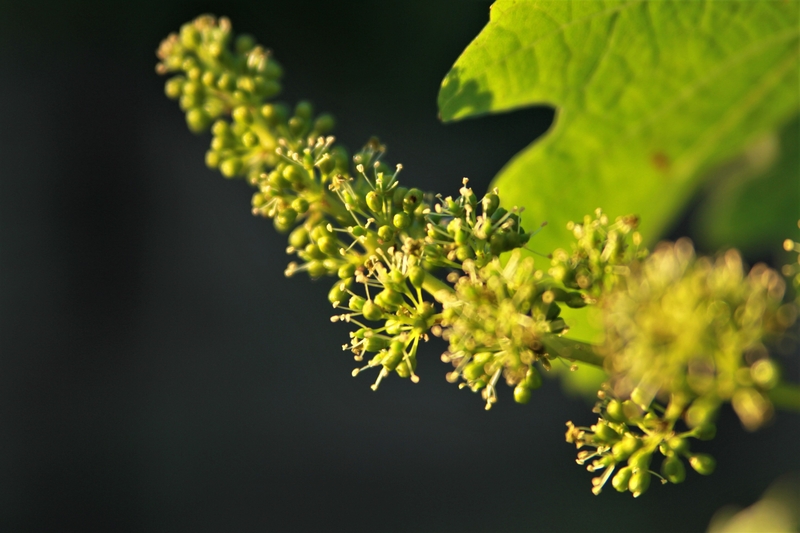
The grape cluster are in full bloom with little flowers popping out. The berries that become pollinated will develop seeds and mature into full sized gapes with sweet juice and thick flavorful skins. The berries that are not pollinated don’t develop seeds. They stay small, hard and green and then drop (called shatter).
Grapes are self-pollinating, they don’t need birds and bees to deliver pollen from one flower to the next. If you look at the picture, you will see thousands of tiny flowers sticking out and above the BB sized grapes. They are positioned in such a way that when they release their pollen it naturally finds its home. That is, as long and there is a bit of a Goldie Locks window of weather when it happens. Meaning it can’t be too hot, too cold, too windy or rain too much. Last week’s 30 MPH plus winds followed by triple digit heat has me very concerned. It will be a month before we know if the flowers released their pollen during these extreme conditions. One good thing about my Kitoko vineyard is that I have a range of elevation and aspects relative to the sun resulting in various blocks developing at different rates.
When the photos were taken the vines at the top of the North Block were in full bloom. Vines 300 feet lower in elevation at the bottom of the hill had no flowers. I am afraid I may have lost some fruit to high wind and heat. In a month I will know how much.
I will keep you posted.
The Cave Update
June 1st, 2019I have long dreamt of having my own winery, and I am ready to build a cave!
After working on plans for over a year, I submitted themwith all the crazy requirements the county requested in September 2017! The clock is still ticking but the county hasn’t even given me a date for a hearing… There is some serious dysfunction in the county and a lot of misguided, anti-winery sentiment from a portion of the local population. Despite this driving me crazy at times, I am staying positive, and keep pushing to get an answer. My plan is to build an underground cave for barrel storage and a tank room for fermentation and a small building in front of the cave with offices, and a tasting room to receive you with a beautiful view of the vineyard. More to come on this front—when there is movement or when I blow a fuse— which happens regularly.
What is Reduction, and why is Racking necessary?
February 5th, 2019In an environment without air, like the bottom of a wine barrel, yeast can release sulfide compounds that don’t smell so nice. This is a form of “reduction.” “Racking” is the process of moving the wine from its barrel to another barrel or a tank. The process removes sediments that drop at the bottom of the barrel that can give bad flavors to the wine. Once empty, the barrel is cleaned with hot water and steam to remove sediments stuck inside the barrel. The barrel is left to dry and wine is put back in the barrel. An added benefit of racking is that it adds some oxygen (oxygenation; a good thing) to the wine, which reverses reduction and helps the wine mature. Done properly, this will allow more precision and clarity in the wine.
Vintage 2017 Outlook
March 31st, 2019The 2017s were blended in February and put back to barrel. It takes a while for the various lots that went intothe three blends to really integrate well. The wines are coming along nicely. Get ready for very big wines with the ‘17s. This was the vintage of the fire, and I’m very happy and relieved to report that there is no smoke taint in the wines. (I’ve had others smell and taste Hesperian’s ‘17s, and they tell me the same. Relief!)
The 2018s are fantastic, perhaps the best wines I’ve made so far. We are almost done with the first racking; some wines were starting to reduce a bit and they needed some air. Alas, we have to be patient. We won’t see these wines coming available until 2021.
Happenings in The Vineyard
April 30th, 2019By now you may know that I am a perfectionist in the vineyard, which requires a lot of tromping back and forth, up and down the slopes. I’m finding that it has been getting progressively harder these past few years to find help in the vineyard. At the moment we are suckering the vines. The rain prevented us from working two days lastweek, so we had to work over the weekend to catch up. I’m hoping to get a big team this weekend to put a big dent on this operation.
What is Suckering? “Suckering” is the removal of all unnecessary shoots which grow on vines as weather warms up. This process can take up to two passes through the vineyards. The purpose is to focus the plants’ energy only on the shoots we want to bear fruit.
Once we are done with suckering, we’ll start putting the vine canes in the trellis so that they grow straight up and don’t fall to the ground. This operation is done twice, the first time to tuck them in the first wire, and the second one once the canes have passed the second wire.
Rain in May
May 22nd, 2019I feel compelled to discuss the weather we’ve been having. Rain in May? It doesn’t happen very often, but as you’re likely aware, we got a good soaking recently. It will be interesting to see the results of this rain on the 2019 fruit quality at harvest. I suspect that the abundant water supply in the soil will make the berries down the hill on the valley floor very big this year (not necessarily such a good thing). For me it shouldn’t be much of a problem; my vineyard’s Atlas Peak soil is so rocky that there isn’t much to hold all the rainwater in storage for the plants to use later (a good thing).
